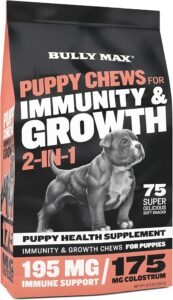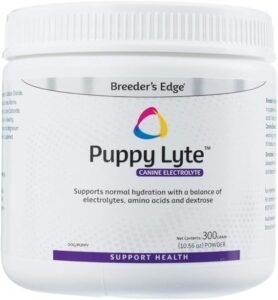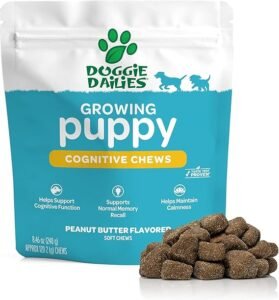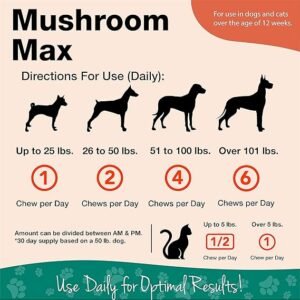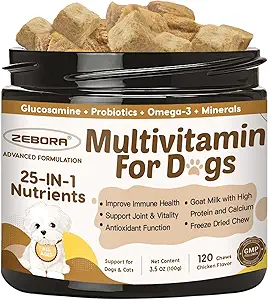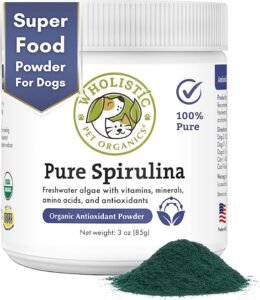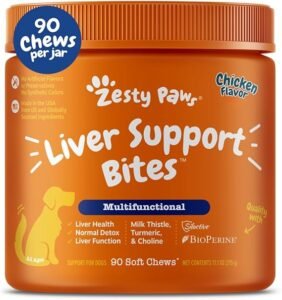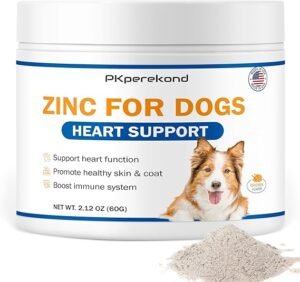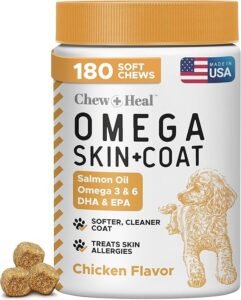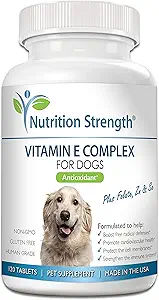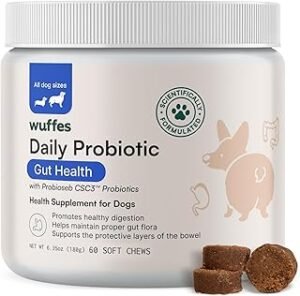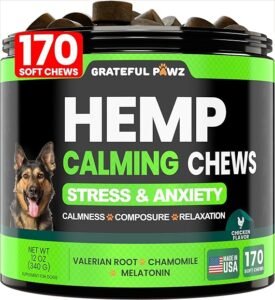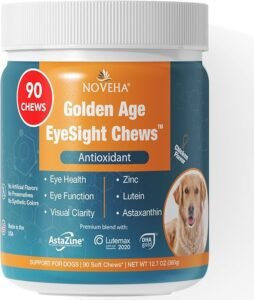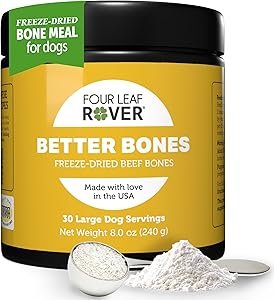Working Breeds
German Shorthaired Pointer Colors: Genetics Care

A Complete Guide
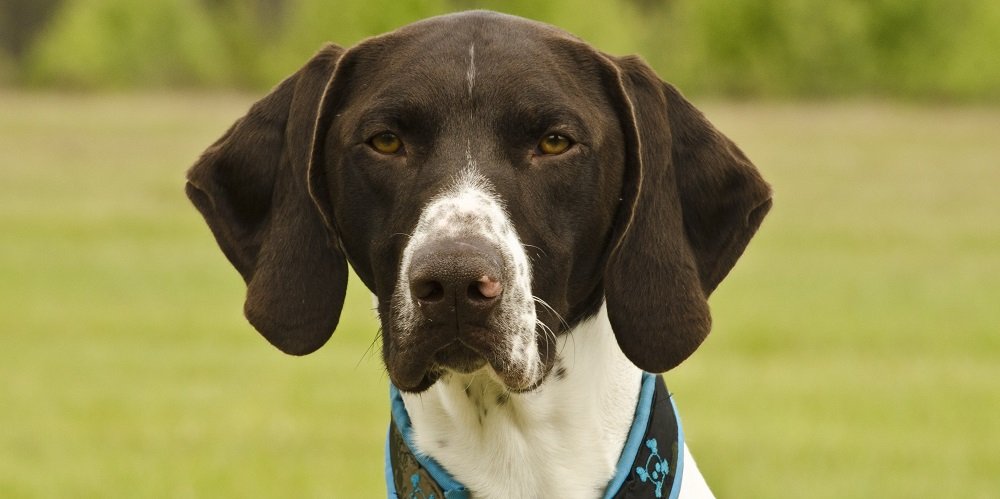
The German Shorthaired Pointer colors (GSP) is a versatile and energetic breed known for its distinctive coat patterns and colors. This breed’s colors are not only aesthetically pleasing but also functional, helping it blend into natural environments during hunts. Below is a detailed exploration of the colors, patterns, and genetics of German Shorthaired Pointers.
For more information regarding 4 seasonal cxcercieses of all dog breeds recommended by the doctors and experts,you can visit our youtube channel:
The breed standards
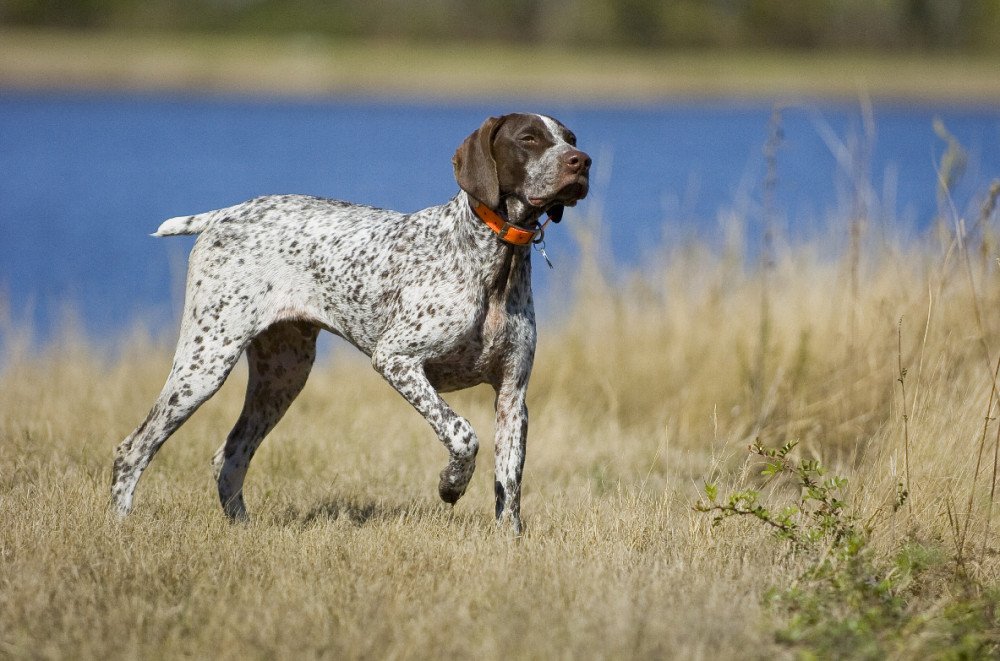
The breed standards for the German Shorthaired Pointer (GSP) are specific guidelines that define the ideal characteristics, appearance, and behavior of this breed. These standards are established by kennel clubs like the American Kennel Club (AKC), United Kennel Club (UKC), and others. Below is an outline of key points regarding the German Shorthaired Pointer’s breed standards:
General Appearance

The German Shorthaired Pointer is a medium to large-sized dog with a balanced, athletic, and well-muscled build. It exudes elegance, endurance, and versatility as a sporting dog.
Size
- Height:
Males: 23–25 inches (58–64 cm) at the withers.
Females: 21–23 inches (53–58 cm) at the withers.
- Weight:
Males: 55–70 pounds (25–32 kg).
Females: 45–60 pounds (20–27 kg).
Head
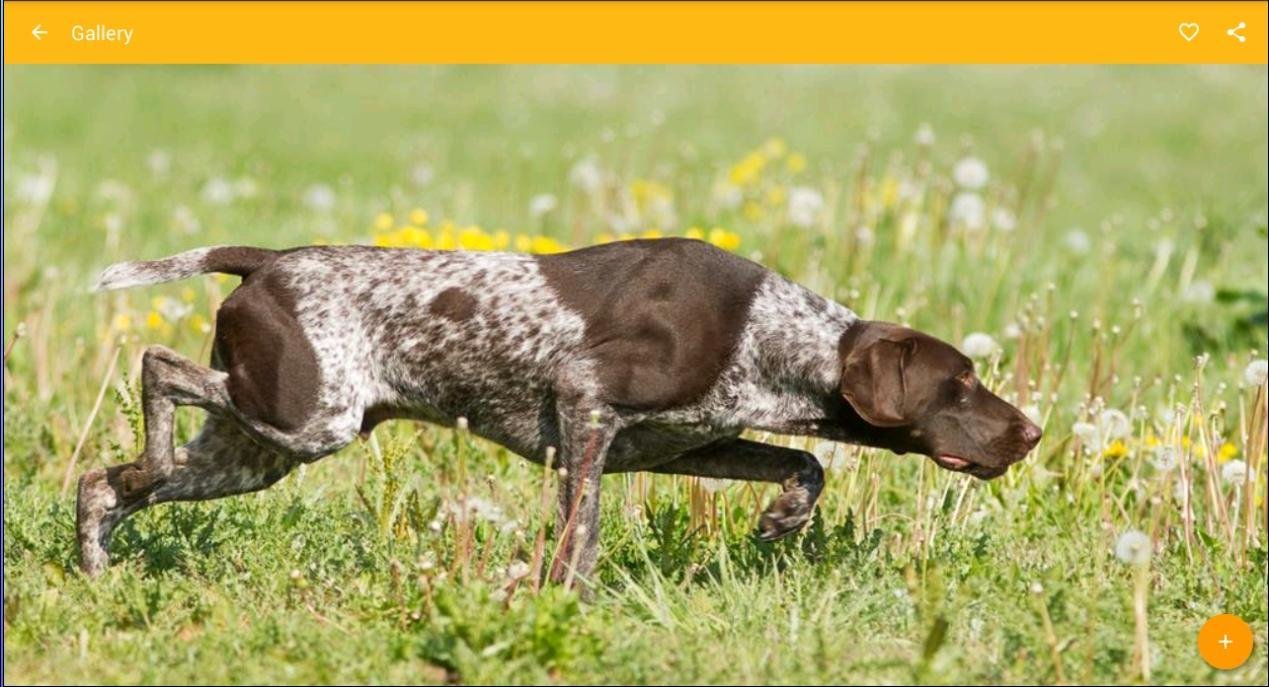
- Skull:
- Moderately broad, slightly rounded on top.
- Muzzle:
- Long and strong, with a slightly pronounced stop.
- Eyes:
- Medium-sized, almond-shaped, and expressive, typically dark brown.
- Ears:
- Set high, broad, and lying flat close to the head.
Body
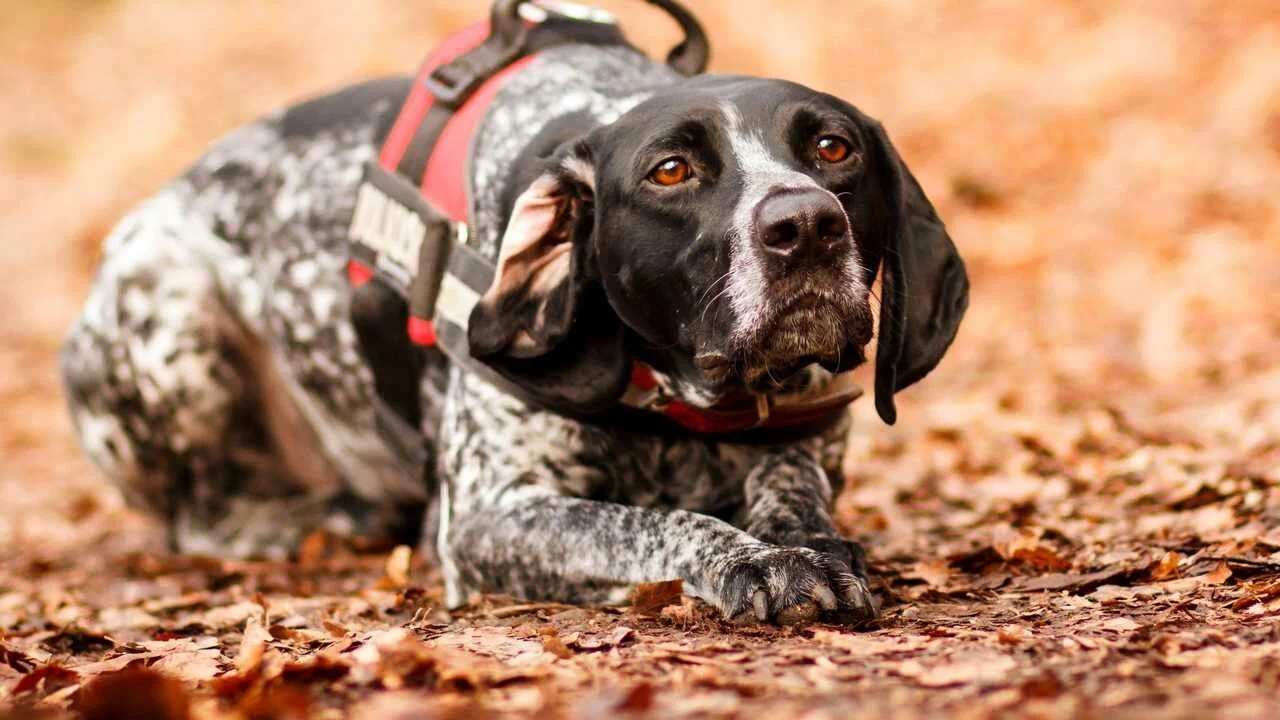
- Neck:
- Long and muscular, blending smoothly into the shoulders.
- Chest:
- Deep and well-developed, reaching the elbows.
- Back:
- Short and firm, with a slight slope from the withers to the tail.
- Tail:
- Set high and docked to about 40% of its natural length in countries where docking is legal.
Coat
- Type:
- Short, dense, and weather-resistant.
- Texture:
- Smooth and firm to the touch.
- Color:
- Solid liver.
- Liver and white (patched, ticked, or roan).
- Combinations of liver with speckling or spotting.
Gait
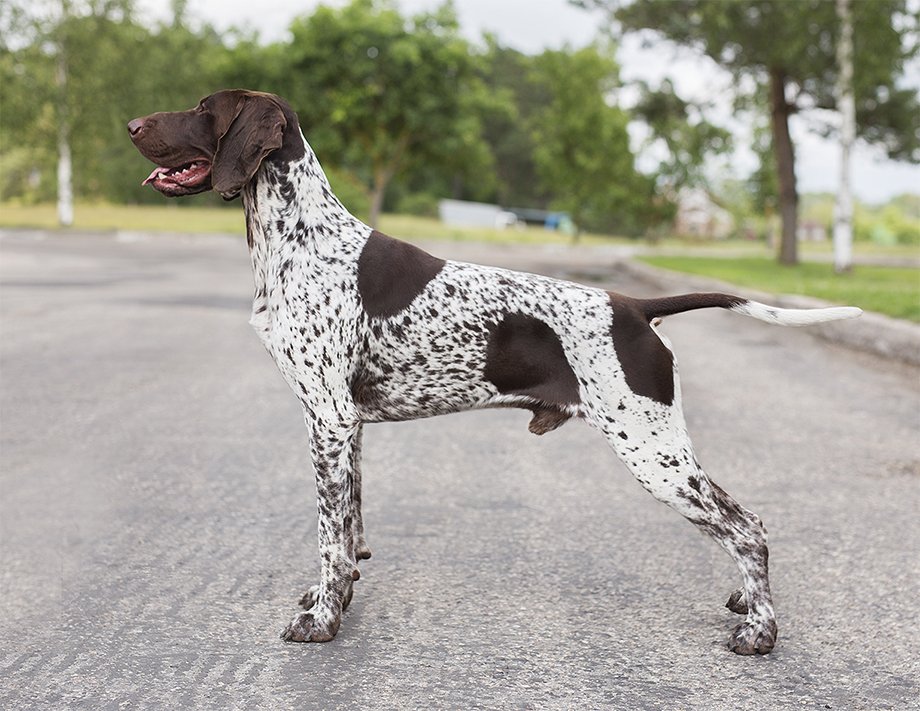
Efficient, smooth, and ground-covering. The movement is balanced and demonstrates the breed’s athletic ability.
Temperament
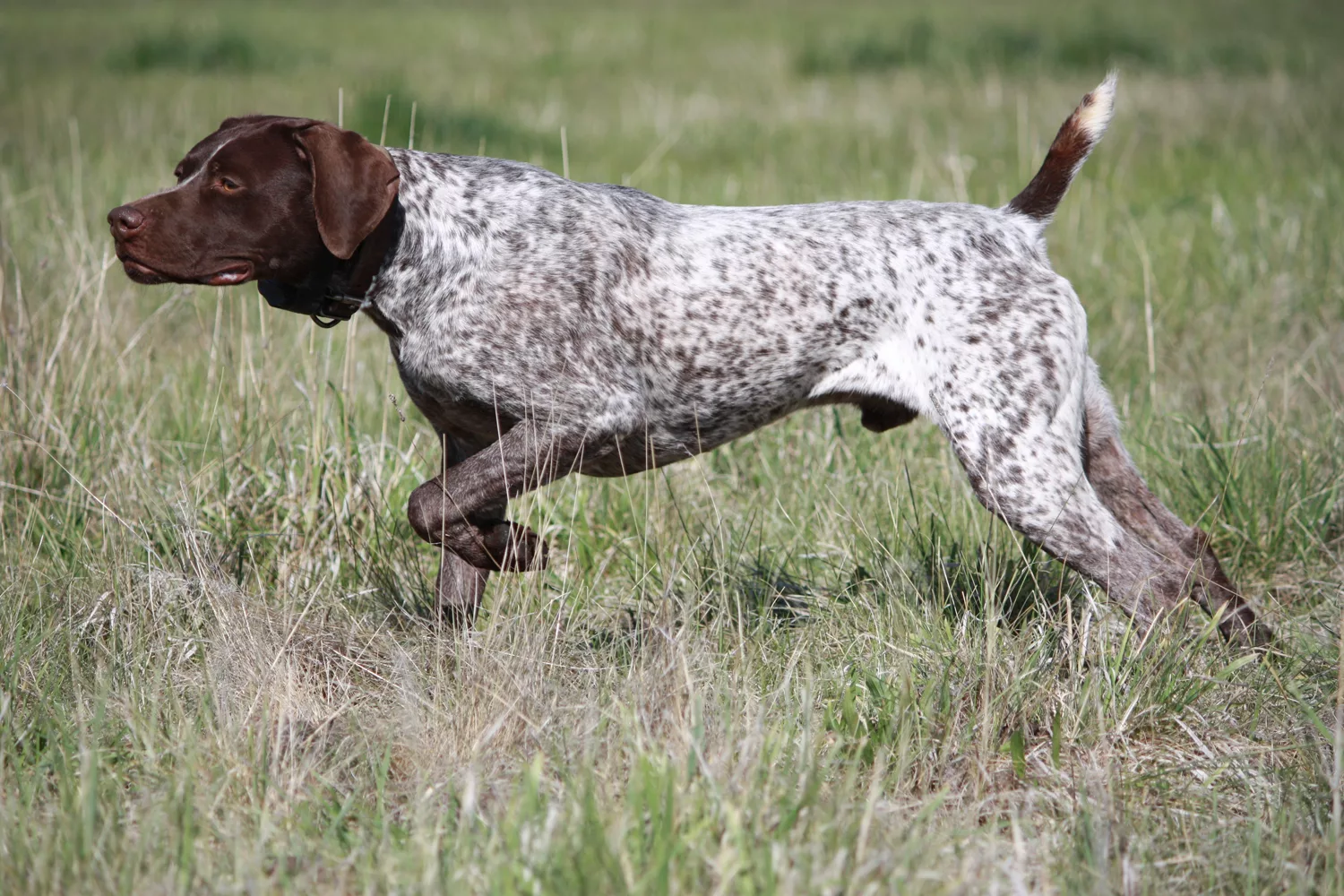
The breed is known for its intelligence, energy, and eagerness to please.
It is friendly, affectionate, and highly trainable.
The GSP is versatile, excelling in hunting, obedience, agility, and as a family companion.
Health
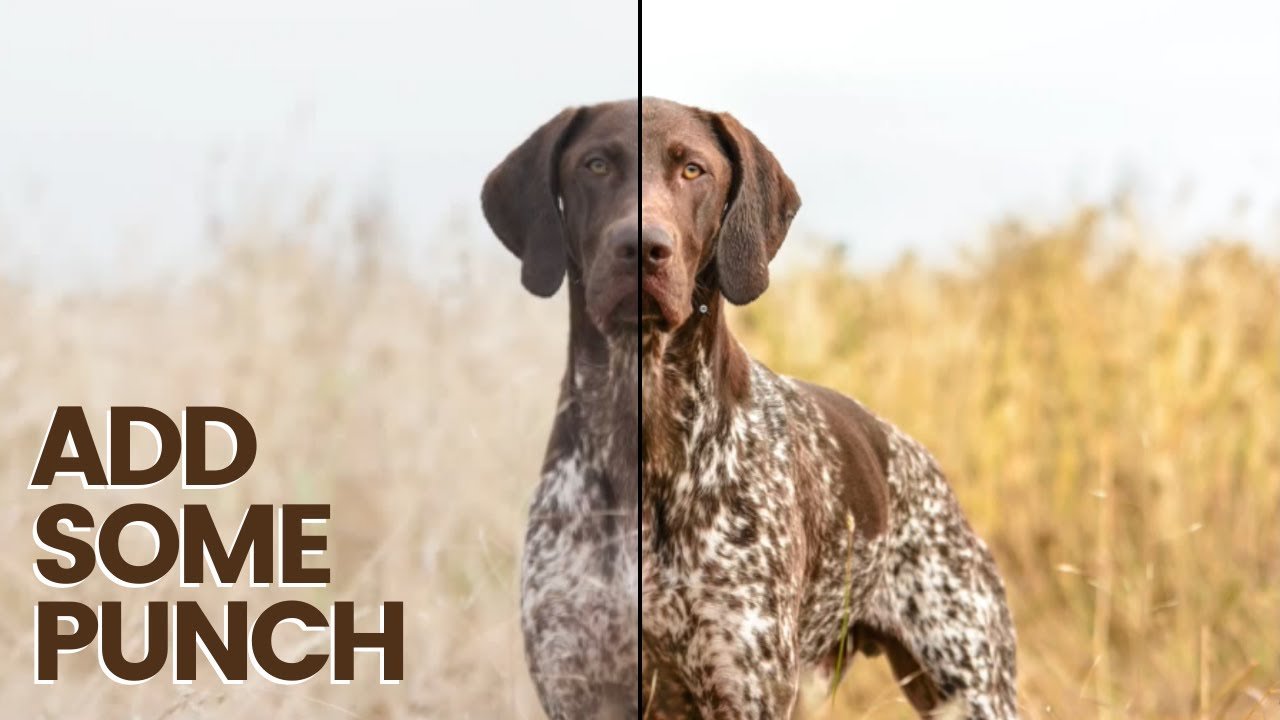
The breed standard emphasizes soundness and functionality, discouraging traits that lead to genetic health issues.
For further details and official documents, refer to:
- American Kennel Club – German Shorthaired Pointer Standards
- United Kennel Club – GSP Standards
- Federation Cynologique Internationale (FCI).
Recognized Colors of German Shorthaired Pointers

- Solid Liver
- This is a rich brown color covering the entire body without any markings. It’s sleek, elegant, and showcases the breed’s strong physique.
- Liver and White
- This combination features patches of liver color on a white base. It’s common and widely loved for its balance of elegance and function.
- Liver Roan
- A mixture of liver and white hairs creating a “roan” effect. This pattern is particularly popular and helps the GSP remain camouflaged in wooded or grassy areas.
- Liver and White Ticked
- Small, speckled markings of liver on a white coat. This pattern gives the breed a freckled appearance, enhancing its visual appeal.
- Liver and White Patched
- Large liver patches on a predominantly white coat. This pattern is often paired with ticking.
Genetic Factors Behind the Coat Colors

The coat colors of GSPs are determined by genetic factors that influence pigmentation:
- Dominant and Recessive Genes:
- The liver color is dominant in the breed, while white is recessive, resulting in variations like ticking and roan.
- Eumelanin and Phaeomelanin:
- These pigments are responsible for the brown (liver) and white colors seen in GSPs.
Genetic Factors Behind Detailed Table
| Genetic Factor | Description | Influence on Coat Color |
|---|---|---|
| Liver (B Gene) | The liver color is determined by the dominant B allele. A recessive b allele results in liver coloration. | Produces solid liver or liver-dominant patterns. |
| White (Spotting Gene – S) | The white base coat or patches are controlled by variations of the S gene. | Results in liver and white, ticking, or patched patterns. |
| Ticking (T Gene) | The ticking gene introduces speckles of liver on white areas. | Produces liver-ticked patterns. |
| Roan (R Gene) | Roaning results from the intermixing of liver and white hairs. | Responsible for liver roan patterns. |
| Black Coat Variants (K Gene) | While rare, the K locus can introduce black coat patterns when present. | Results in black and white or black roan patterns. |
| Eumelanin and Phaeomelanin | Eumelanin creates darker colors like black or liver, while phaeomelanin affects lighter areas. | Controls the intensity and spread of liver or black pigmentation. |
Notes on Genetic Interactions:

- Dominance Hierarchy:
- The liver color dominates over black when the liver allele is present.
- Complex Patterns:
- Roaning and ticking often appear together due to overlapping genetic effects.
- Health Implications:
- Certain coat colors and patterns, like extreme white, can be linked to congenital health concerns in some breeds, though this is rare in GSPs.
Genetic Factors Behind The Coat Colors Detailed Description With References
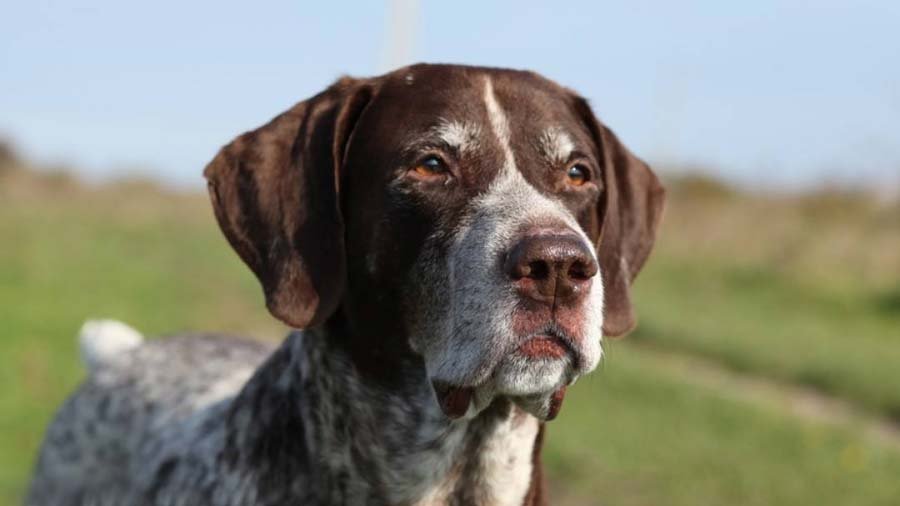
The coat colors of German Shorthaired Pointers (GSPs) are determined by specific genetic factors, primarily influenced by loci such as the B locus (responsible for black and liver colors) and the spotting genes affecting white and roan patterns. These genes dictate the wide range of coat appearances seen in GSPs, including solid liver, liver and white, liver roan, and various ticked patterns. Variations depend on the inheritance of dominant and recessive alleles from parent dogs. Breeders often study these genetic factors to produce puppies with desirable and breed-standard coats【481†source】【482†source】.
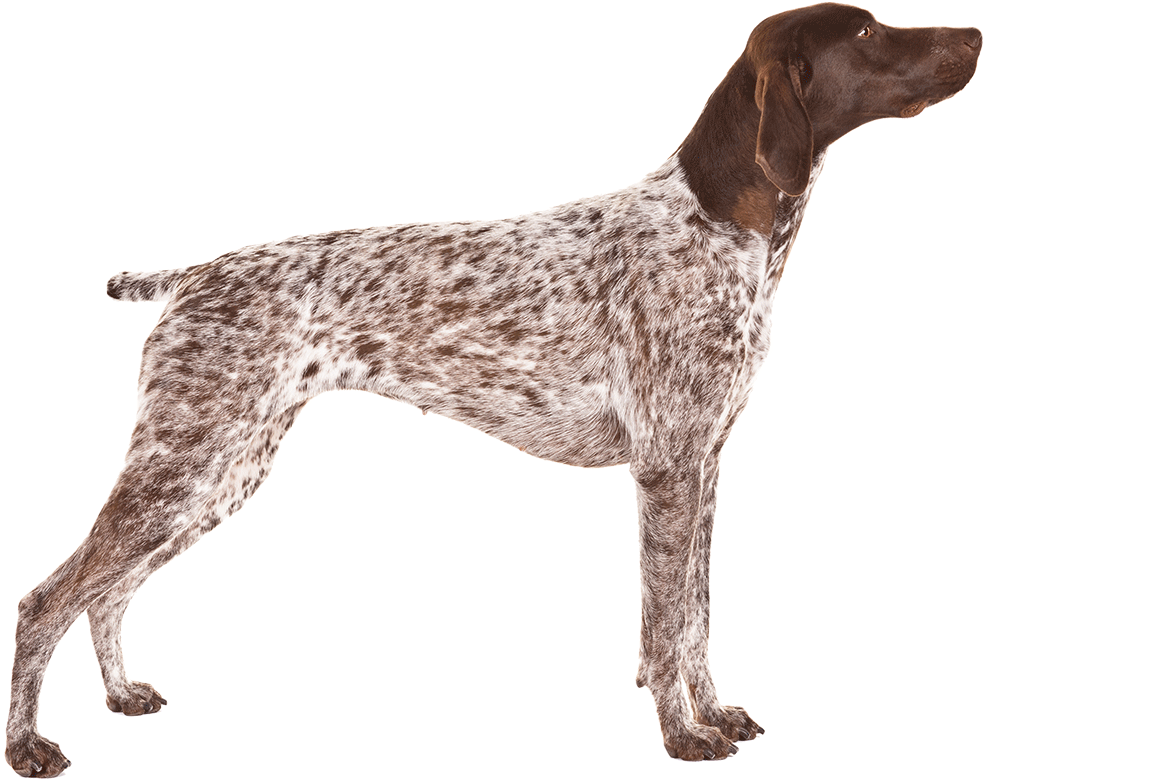
For instance, liver coloration is common due to the prevalence of recessive alleles in the breed’s gene pool, while roan patterns result from specific spotting gene combinations. These traits are carefully maintained through responsible breeding practices to uphold the breed’s unique appearance and functionality in hunting and companion roles【481†source】.
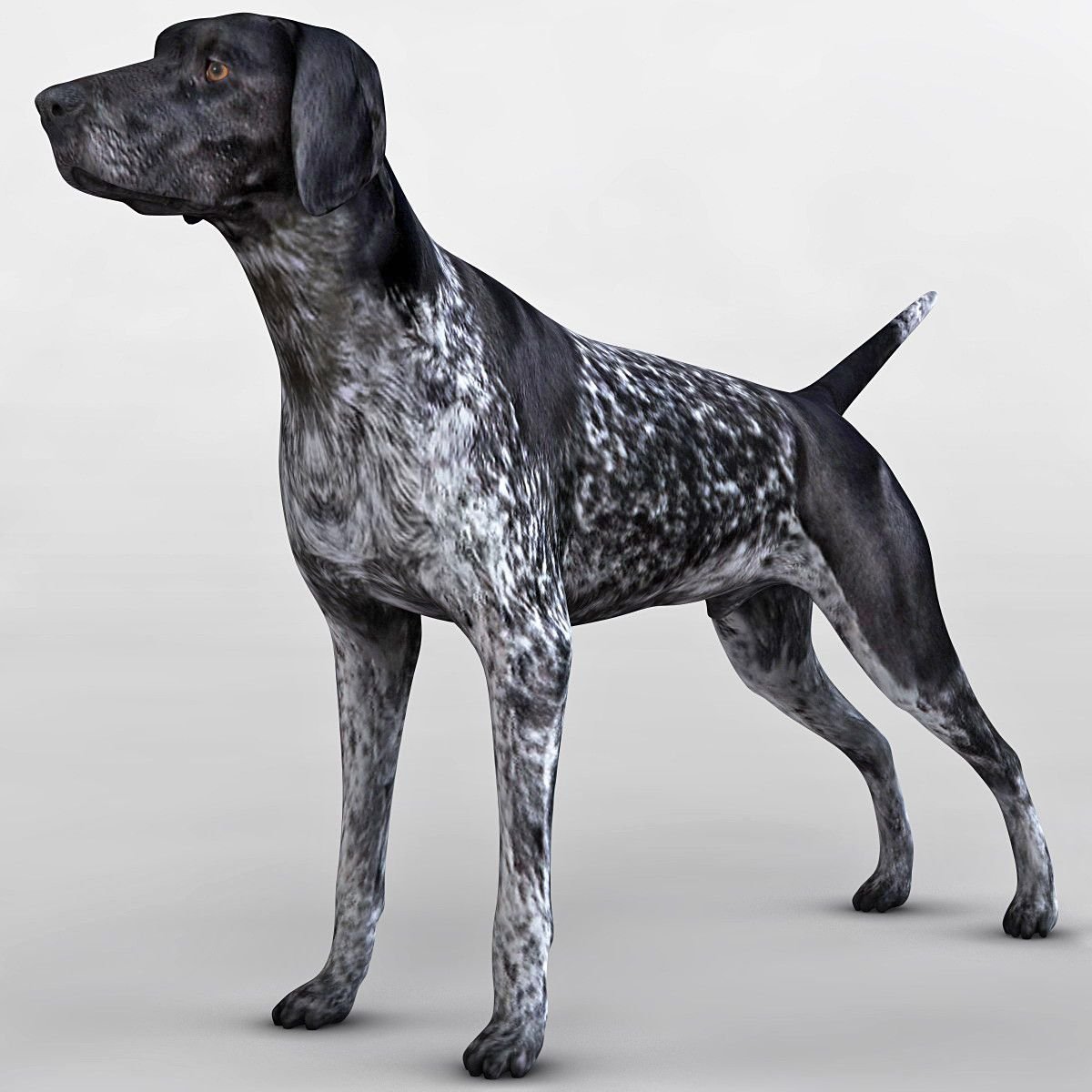
If you’d like to explore more about coat color genetics in German Shorthaired Pointers, additional resources are available at DogColorGenetics and SevenStar ShortHairs.
Coat Patterns and Functionality
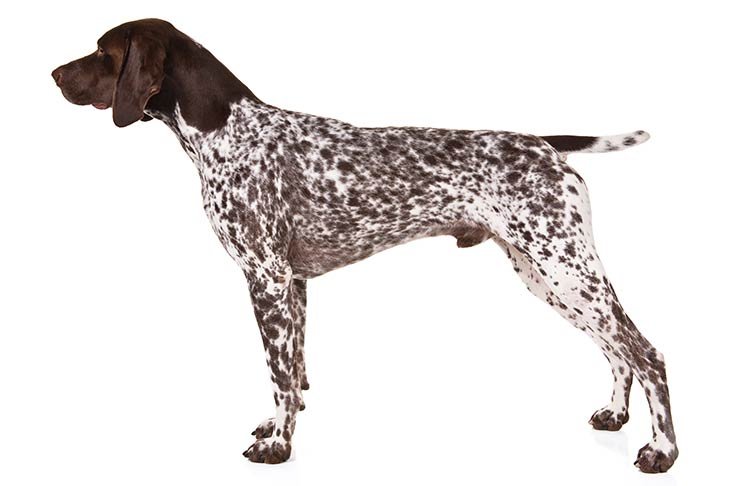
- Camouflage:
- The liver, roan, and ticking patterns allow GSPs to blend into natural environments, making them exceptional hunting companions.
- Visibility:
- White markings enhance visibility in open fields, aiding handlers in spotting their dogs from a distance.
Patterns Table

| Coat Pattern | Description | Functionality |
|---|---|---|
| Solid Liver | Entire coat is a rich liver color without any white or roan patches. | Ideal for camouflage in dense foliage during hunting; reflects the breed’s origins as a versatile hunting dog. |
| Liver and White | Base white coat with large liver patches or saddle-like markings. | Provides visibility in open terrain while retaining a camouflage aspect for hunting. |
| Liver Roan | Mottled or interspersed liver and white fur, giving a “salt and pepper” appearance. | Offers a blend of visibility and camouflage, with added aesthetic appeal for show purposes. |
| Liver and Ticked | White coat with liver-colored spots (ticking), often appearing on the legs and face. | Ticking enhances visibility in water or snowy environments, aiding in recovery of hunted game. |
| Liver Saddle with Roan | Saddle-shaped liver marking on the back, combined with roan patterns on other parts of the coat. | Combines functionality for hunting and aesthetic distinctiveness, often preferred in conformation events. |
Explanation of Functionality:

- Hunting Utility:
- The coat patterns often serve specific purposes in hunting scenarios. For example, solid liver or liver roan coats blend well with natural environments, such as forests and fields.
- Visibility and Safety:
- Patterns with white and ticking make dogs more visible in open fields or water, ensuring the safety and ease of locating the dog during hunting or sporting events.
- Aesthetic Appeal:
- Patterns like liver roan or liver saddle with roan are highly prized in show rings, showcasing the breed’s dual-purpose nature as a working and conformation dog.
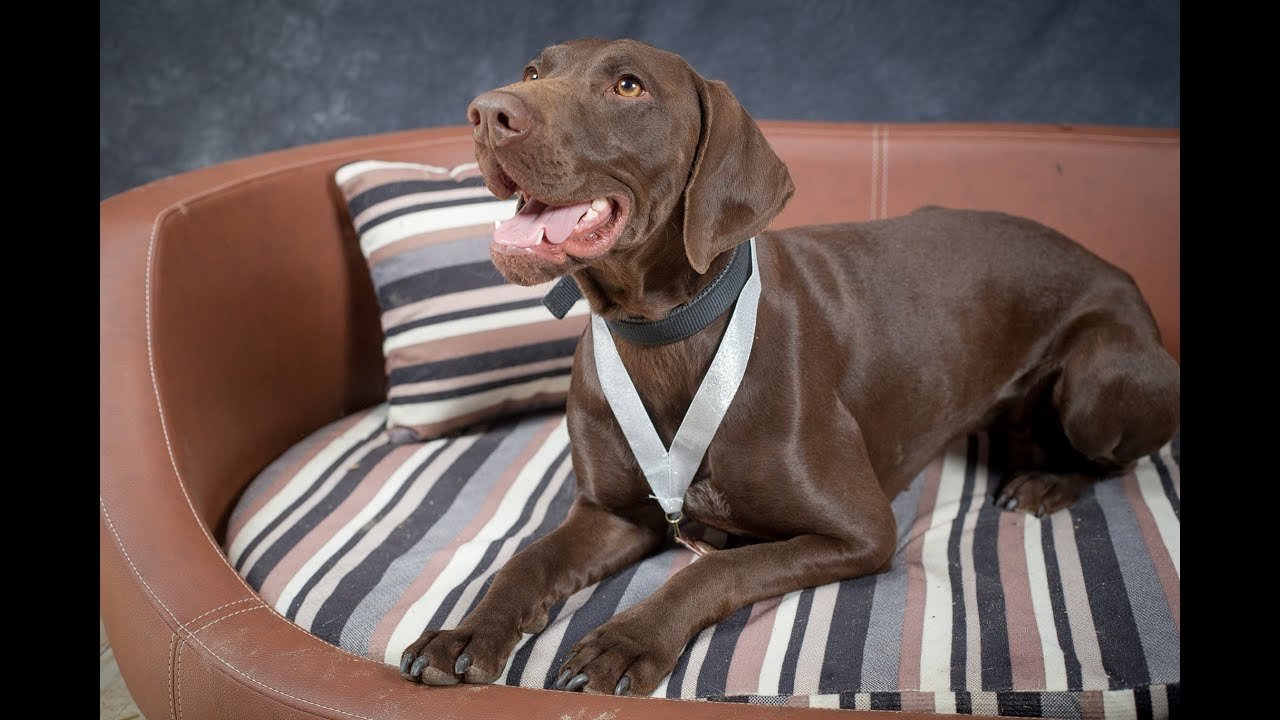
References:
- “German Shorthaired Pointer: A Comprehensive Guide” – AKC Official Site
- “The Genetics of Coat Color and Patterns in Dogs” – DogColorGenetics
Caring for German Shorthaired Pointer Coats

- Brushing:
- Regular brushing helps remove dead hairs and maintain a glossy coat.
- Bathing:
- Use dog-safe shampoos to preserve the natural oils in the coat.
- Diet:
- High-quality protein and omega-3 fatty acids promote healthy skin and coat.
Common Coat Diseases Table

| Disease | Description | Symptoms | Causes |
|---|---|---|---|
| Seborrhea | A skin condition causing oily skin and dandruff. | Flaky skin, greasy coat, unpleasant odor | Genetic predisposition, infections |
| Folliculitis | Inflammation of hair follicles, often secondary to infections or allergies. | Red bumps, scabs, thinning coat | Bacterial or fungal infections |
| Alopecia | Loss of fur in patches or generalized thinning. | Bald spots, dry skin | Hormonal imbalances, parasites |
| Hot Spots | Acute moist dermatitis; inflamed, infected areas of skin. | Red, irritated, moist patches | Allergies, bites, or poor grooming |
| Dermatitis | Inflammatory skin condition, often due to environmental or food allergies. | Itchiness, redness, scaling | Allergens or irritants |
Coat Care Solutions Table

| Issue | Solution | Description | References |
|---|---|---|---|
| Seborrhea | Use medicated shampoos. | Shampoos with sulfur, salicylic acid, or coal tar can help manage symptoms. | VetMD |
| Folliculitis | Apply topical antibiotics. | Vet-prescribed antibiotics or antifungal treatments are effective. | AKC Health |
| Alopecia | Address underlying conditions. | Treatments may include dietary changes, hormone therapies, or addressing parasites. | PetMD |
| Hot Spots | Clean and protect affected areas. | Clean with antiseptic solutions, apply protective ointments, and prevent licking with an e-collar. | Animal Health Trust |
| Dermatitis | Switch to hypoallergenic diet or bedding. | Avoid allergens, use medicated creams or antihistamines under vet guidance. | RSPCA UK |
Additional Notes:
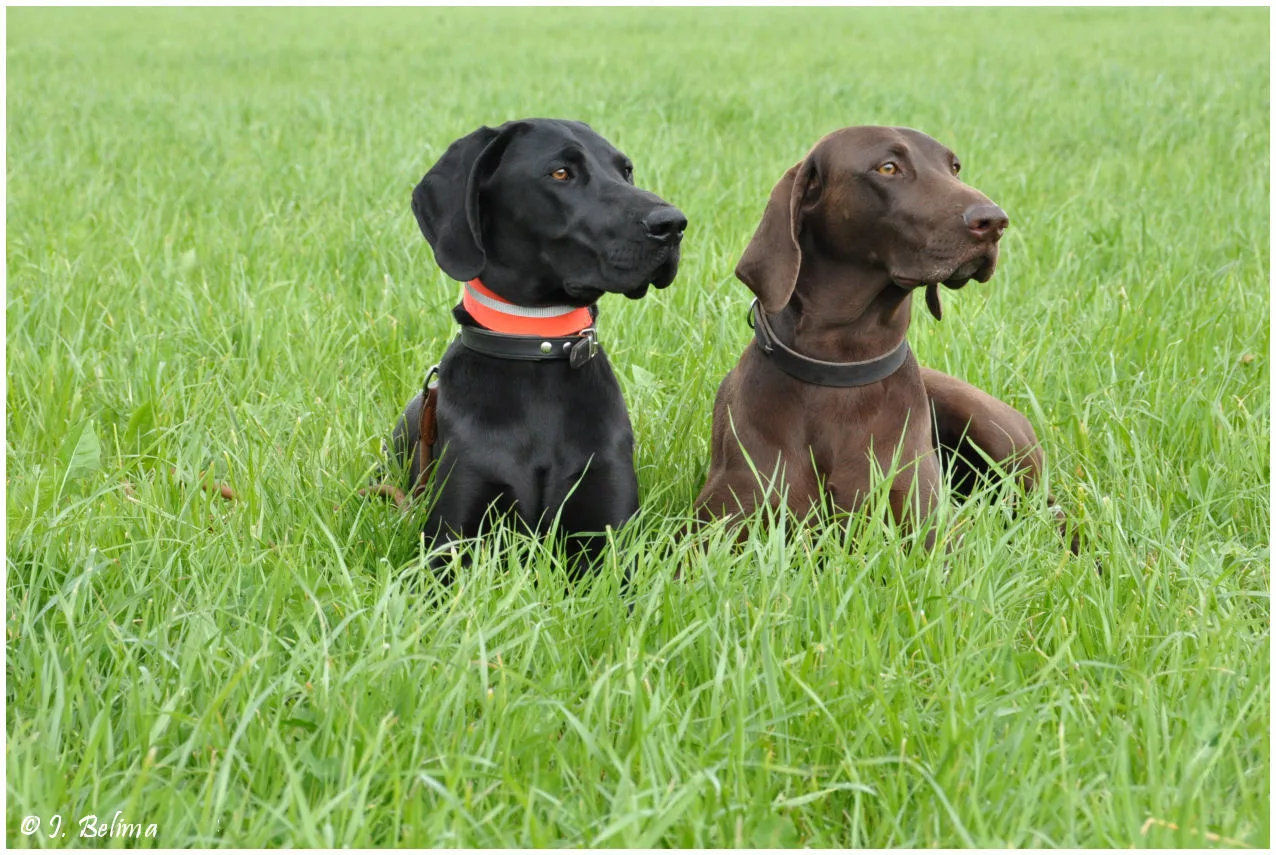
- Regular grooming and skin inspections are key in identifying and preventing coat issues.
- Maintain a balanced diet rich in omega fatty acids to promote healthy skin and fur.
References:
- American Kennel Club: Caring for GSP Coats
- PetMD: Skin and Coat Health in Dogs
- Veterinary Manual: Managing Canine Skin Conditions
Detailed FAQs: German Shorthaired Pointer Colors
Q1: What are the primary coat colors of German Shorthaired Pointers?

A: German Shorthaired Pointers (GSPs) are typically seen in solid liver, liver and white, or black and white. Their coats may include roan, spotted, or patched patterns.
Q2: Can GSPs have solid-colored coats?

A: Yes, GSPs can have solid liver or solid black coats, although liver is more common. These solid coats are recognized by major kennel clubs like the AKC.
Q3: What causes the roan pattern in GSPs?
A: The roan pattern results from a genetic trait where white and liver hairs mix evenly across the body. This trait is influenced by the presence of specific pigmentation genes.
Q4: Are black German Shorthaired Pointers accepted in competitions?

A: Black GSPs are accepted by most international kennel clubs but may face restrictions in some American competitions. Always check the specific rules of the organization.
Q5: Is the coat color indicative of the dog’s temperament or health?
A: No, coat color does not affect the dog’s temperament or health. However, proper breeding practices are essential to ensure genetic diversity and minimize health issues.
Q6: How does liver differ from brown in German Shorthaired Pointers?
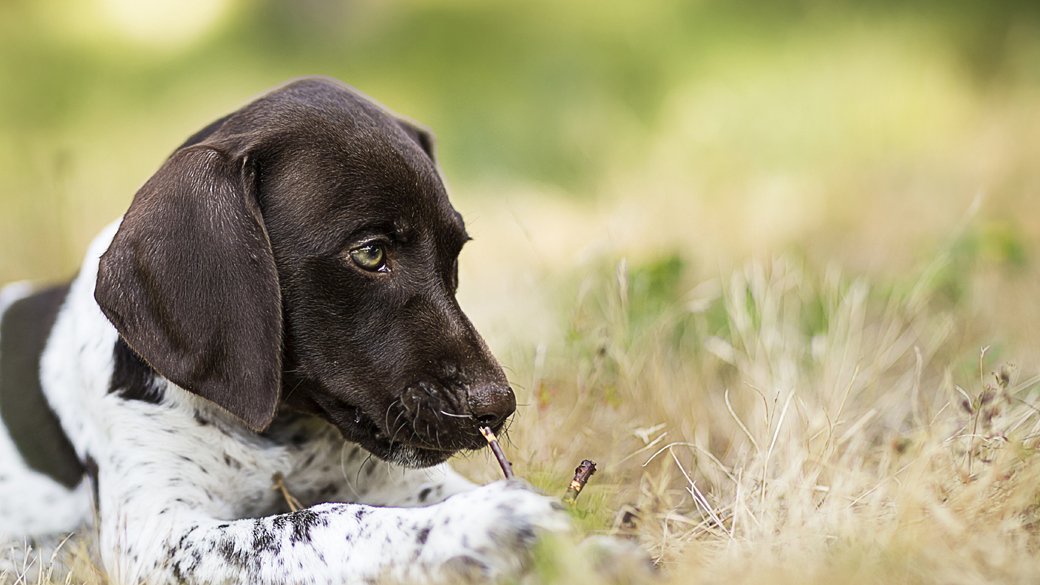
A: In canine terminology, “liver” refers to a rich reddish-brown color distinct from the regular brown seen in some other breeds. This color is a hallmark of GSPs.
Q7: What role do coat patterns play in hunting?
A: Coat patterns, such as spots and patches, provide natural camouflage in outdoor environments, making GSPs effective hunters in various terrains.
Q8: Do lighter coat colors in GSPs require special care?

A: Yes, lighter coats may show dirt more easily and can require frequent cleaning. Additionally, lighter-skinned dogs may need sun protection to avoid skin damage.
Q9: Can GSP puppies change their coat color as they grow?
A: GSP puppies often have lighter or more distinct markings at birth. Their coat may darken or develop a roan pattern as they mature.
Q10: Are certain colors rarer in GSPs?
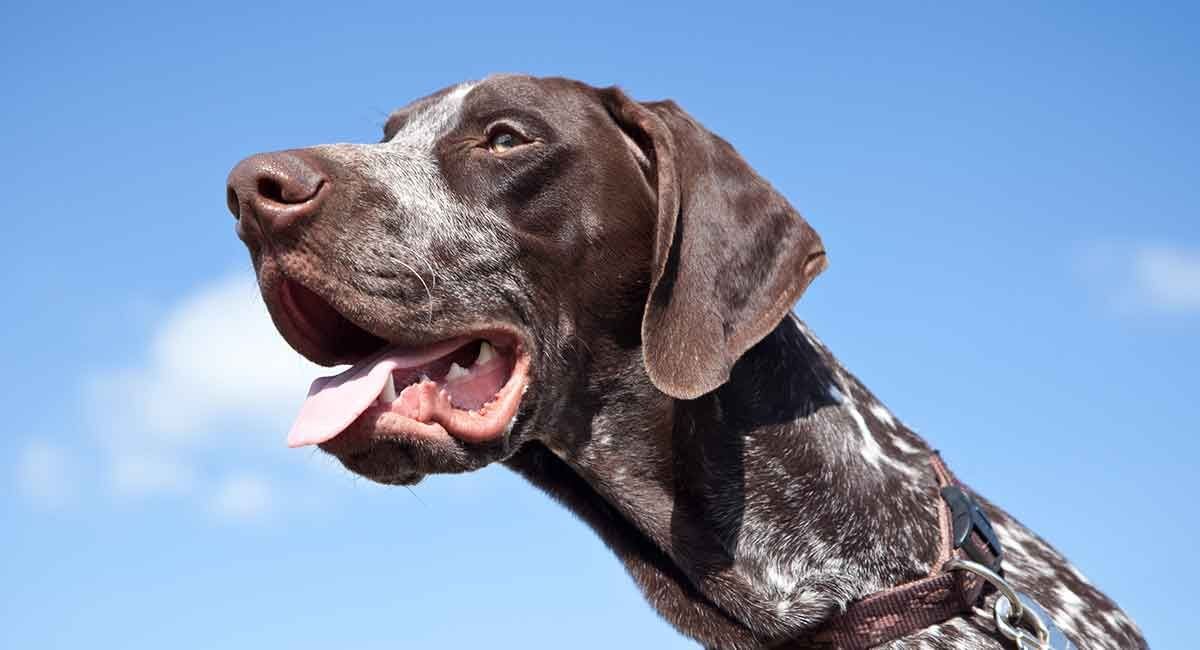
A: Black GSPs and liver roan with minimal white are considered less common than standard liver and white combinations.
Q11: What is the most common coat color in GSPs?
A: Liver and white with a roan or spotted pattern is the most common and widely recognized coat color in German Shorthaired Pointers.
Q12: How does genetics influence coat color in GSPs?
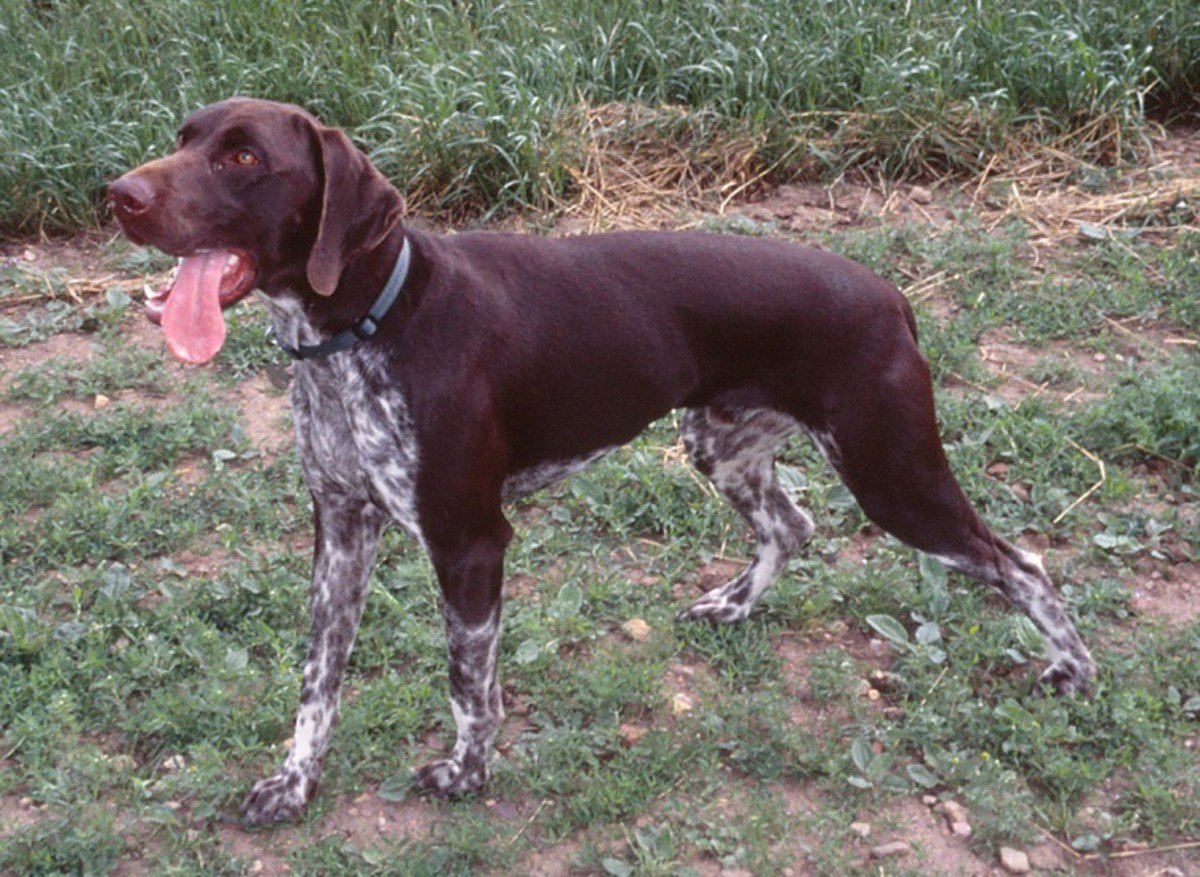
A: Coat colors in GSPs are determined by the interaction of dominant and recessive genes related to pigmentation, such as the B (Black) and E (Extension) loci.
Q13: Are there any health concerns linked to specific coat colors in GSPs?
A: No direct link exists between coat color and specific health issues in GSPs. However, breeding practices focused on rare colors should prioritize overall genetic health.
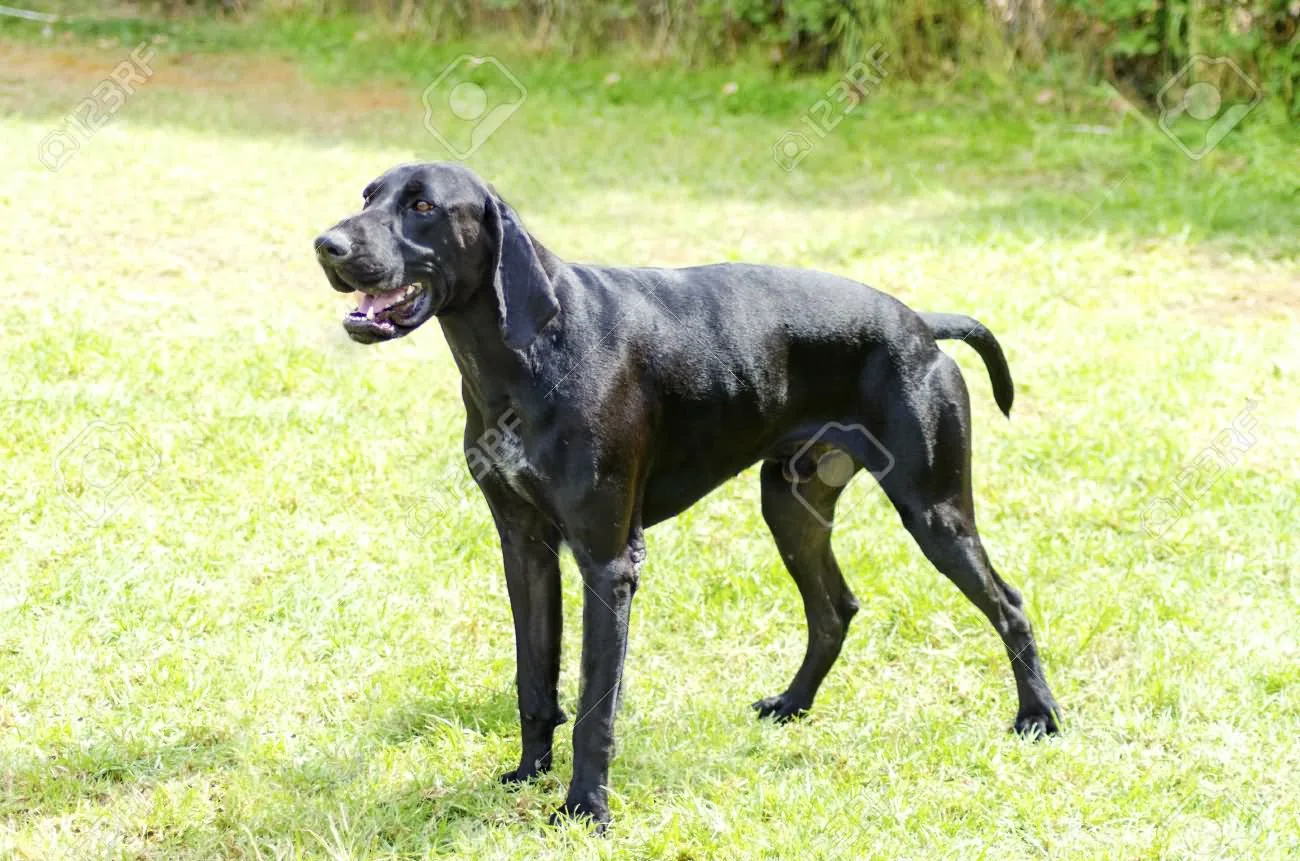
Q14: What should I look for when selecting a GSP puppy based on coat color?
A: While coat color is a personal preference, ensure the puppy is healthy, comes from ethical breeders, and has a good temperament.
Q15: Can GSPs have ticking on their coats?
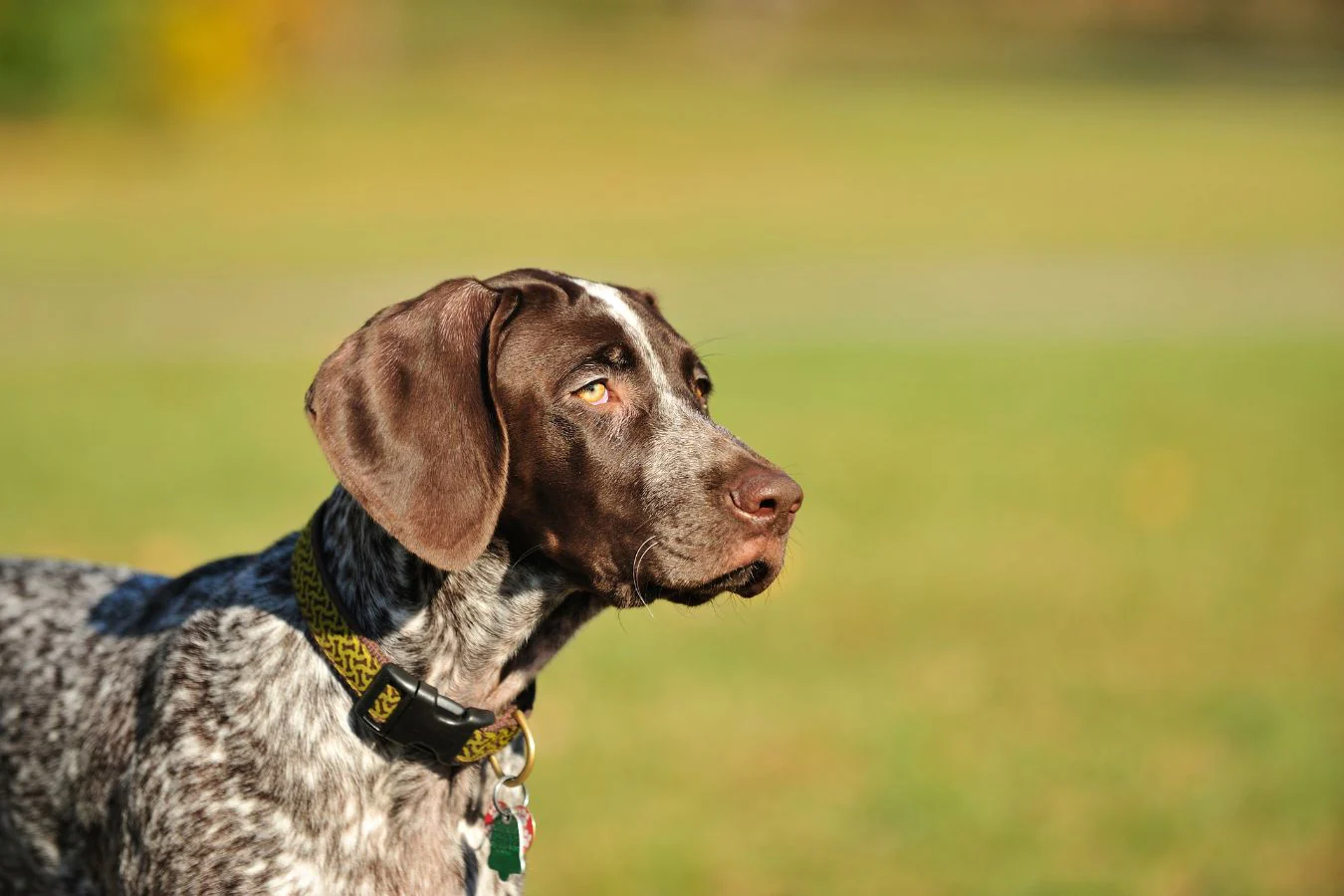
A: Yes, ticking refers to small, individual spots of color, often seen on the white parts of their coat. This pattern is common in GSPs.
References:
- American Kennel Club – German Shorthaired Pointer Colors
- PetMD – Understanding Canine Coat Colors
- Veterinary Genetics Lab – Coat Color Genetics in Dogs
A: No, coat color has no impact on the dog’s behavior or hunting skills.
Latest Research Summary
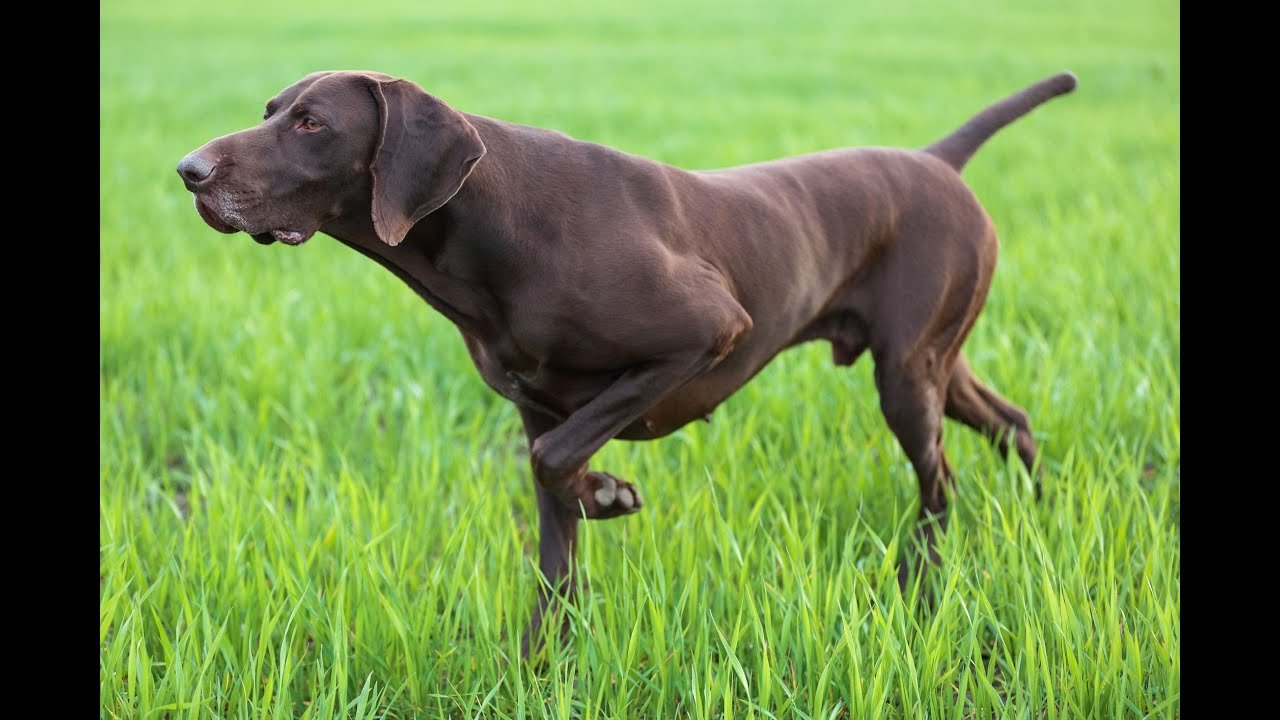
Recent studies have delved into the genetic mechanisms that determine the coat colors and patterns of German Shorthaired Pointers. The breed exhibits a range of coat colors, including liver, black, and white, often combined with unique patterns such as ticking or large patches. These visual traits result from specific genetic combinations involving recessive and dominant alleles.
- Key Findings on Coat Colors:
- The B locus controls the liver versus black base color. Dogs with two copies of the recessive allele exhibit liver-colored coats.
- Ticking patterns, characterized by speckled spots, are influenced by the T locus, adding texture and individuality to the coat appearance【498†source】.
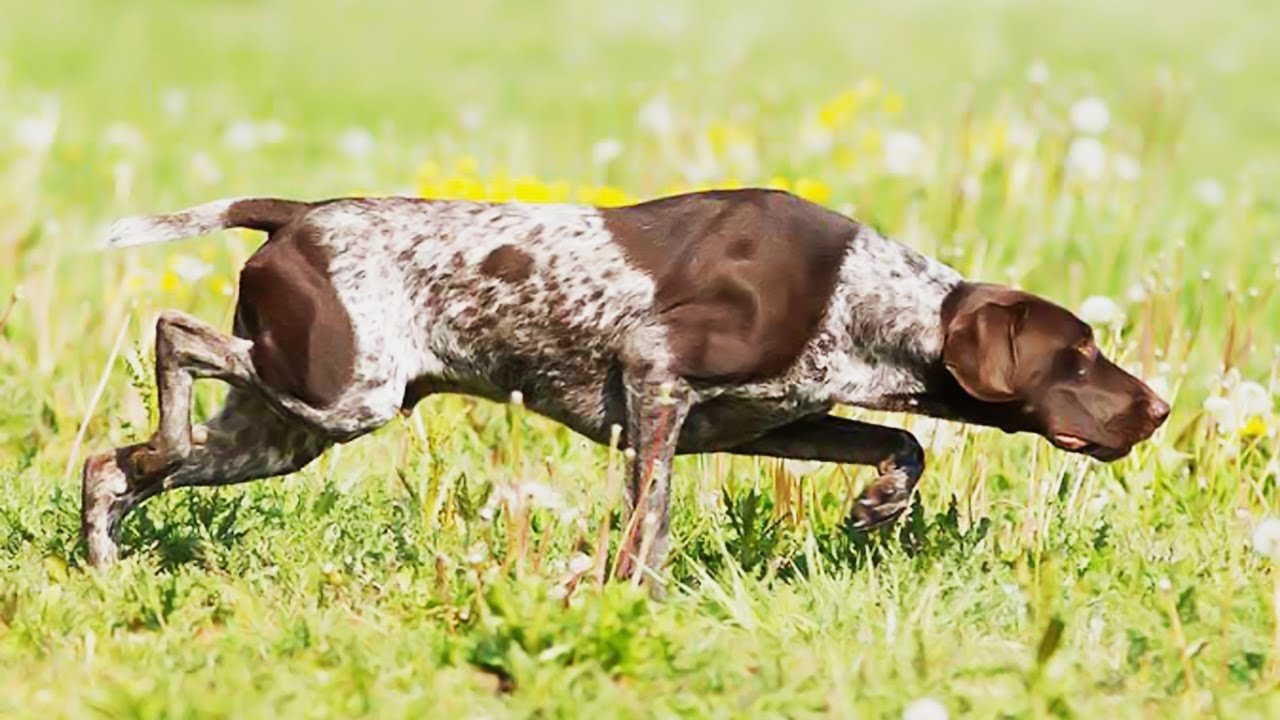
Health and Genetics:
Studies also highlight rare genetic conditions associated with the breed, such as Von Willebrand Disease and cone degeneration. These findings emphasize the importance of genetic testing for both health and aesthetic traits in breeding programs. Advanced genetic testing tools like Embark have become crucial for identifying carriers of specific traits and preventing hereditary conditions in future generations【497†source】【498†source】.
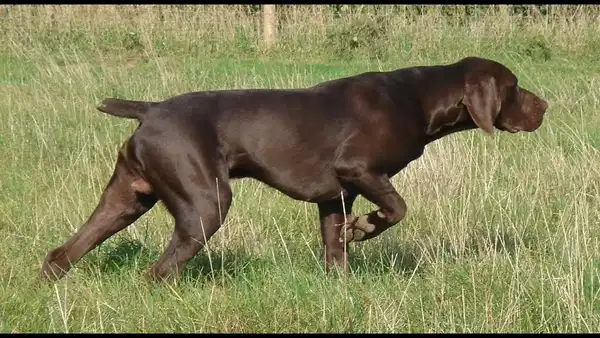
Applications in Breeding:
Research aids breeders in selecting desirable traits while maintaining the health of the breed. It also supports the development of standardized breed characteristics as recognized by organizations like the American Kennel Club (AKC).
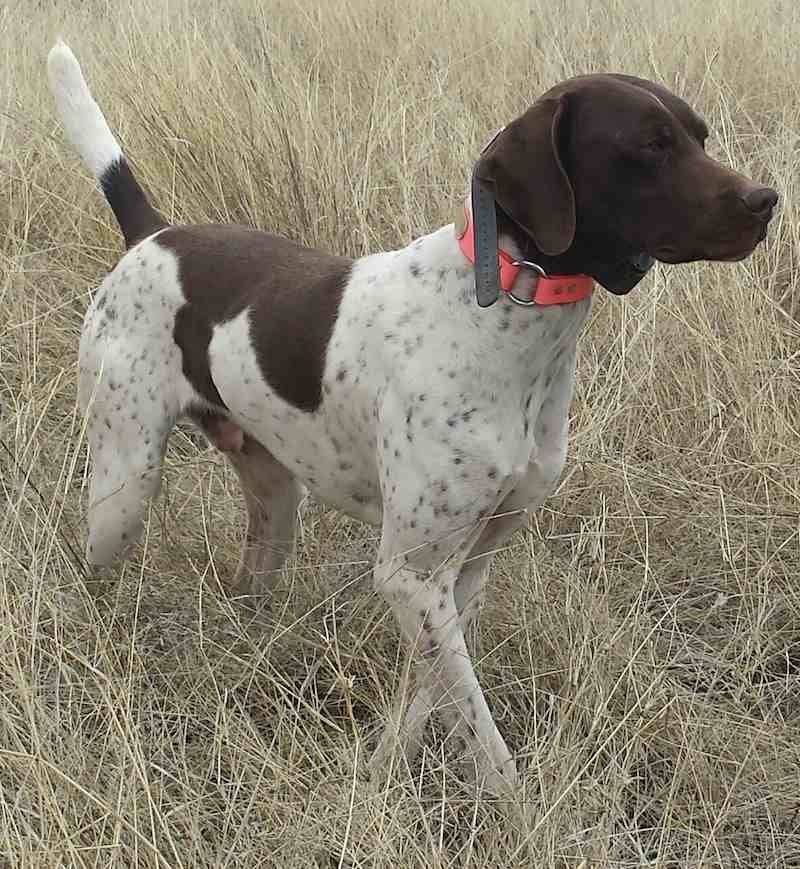
For a deeper exploration of these genetic insights and their implications, you can refer to resources such as the German Shorthaired Pointer Club of America and studies available through genetic testing platforms like Embark【497†source】【498†source】.
Here is a selection of books
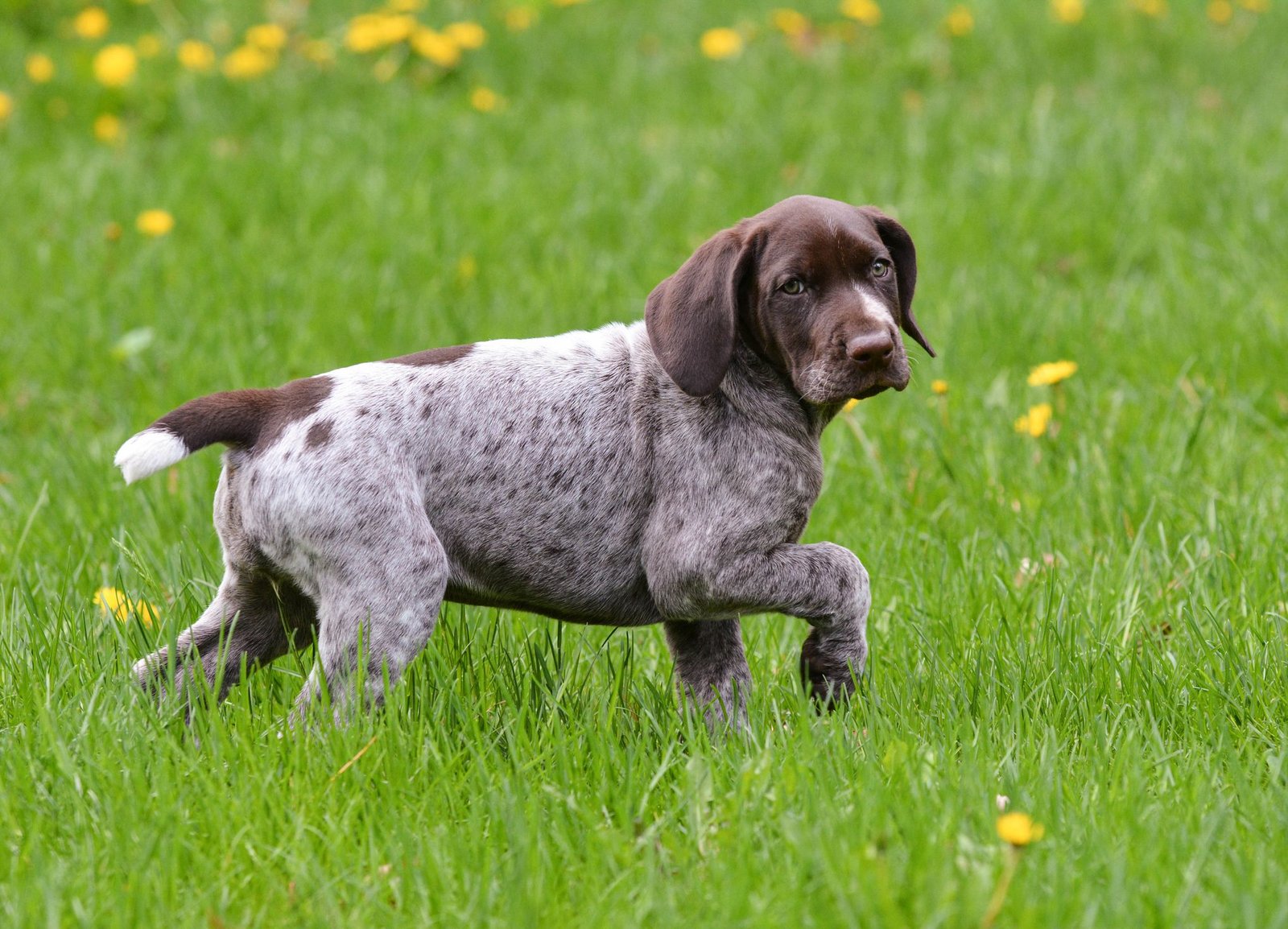
1. “German Shorthaired Pointer: A Comprehensive Guide”
- Description:
- This book provides detailed insights into the history, coat colors, and characteristics of the breed. It also offers tips on grooming and coat care for German Shorthaired Pointers.
- Author:
- Carol Callahan
- Topics Covered:
- Breed history, coat genetics, training, and general care.
2. “The Genetics of Dogs: Understanding Coat Color and Patterns”

- Description:
- A detailed look at canine genetics, focusing on how coat colors and patterns are inherited.
- Author:
- Catherine D. Sirois
- Topics Covered:
- Genetic factors behind dog coat colors, including German Shorthaired Pointers.
3. “Dog Grooming Simplified”
- Description: A practical guide for dog grooming, including specific recommendations for breeds like German Shorthaired Pointers.
- Author: Jodi Murphy
- Topics Covered: Grooming techniques, coat maintenance, and tools for different dog breeds.
4. “Your German Shorthaired Pointer: A Complete Guide”

- Description:
- This comprehensive guide focuses on raising and training German Shorthaired Pointers, with a section on coat care and maintenance.
- Author:
- David S. Smith
- Topics Covered:
- Training tips, nutrition, grooming, and health care.

5. “Canine Coat Colors Explained”

- Description:
- An in-depth exploration of the genetics behind various dog breeds’ coat colors, including practical examples.
- Author:
- Amanda Alexander
- Topics Covered:
- Inheritance patterns, DNA markers, and practical breeding advice.

Working Breeds
German Shepherd Exercise Blueprint: Age-Wise Workouts for Peak Performance
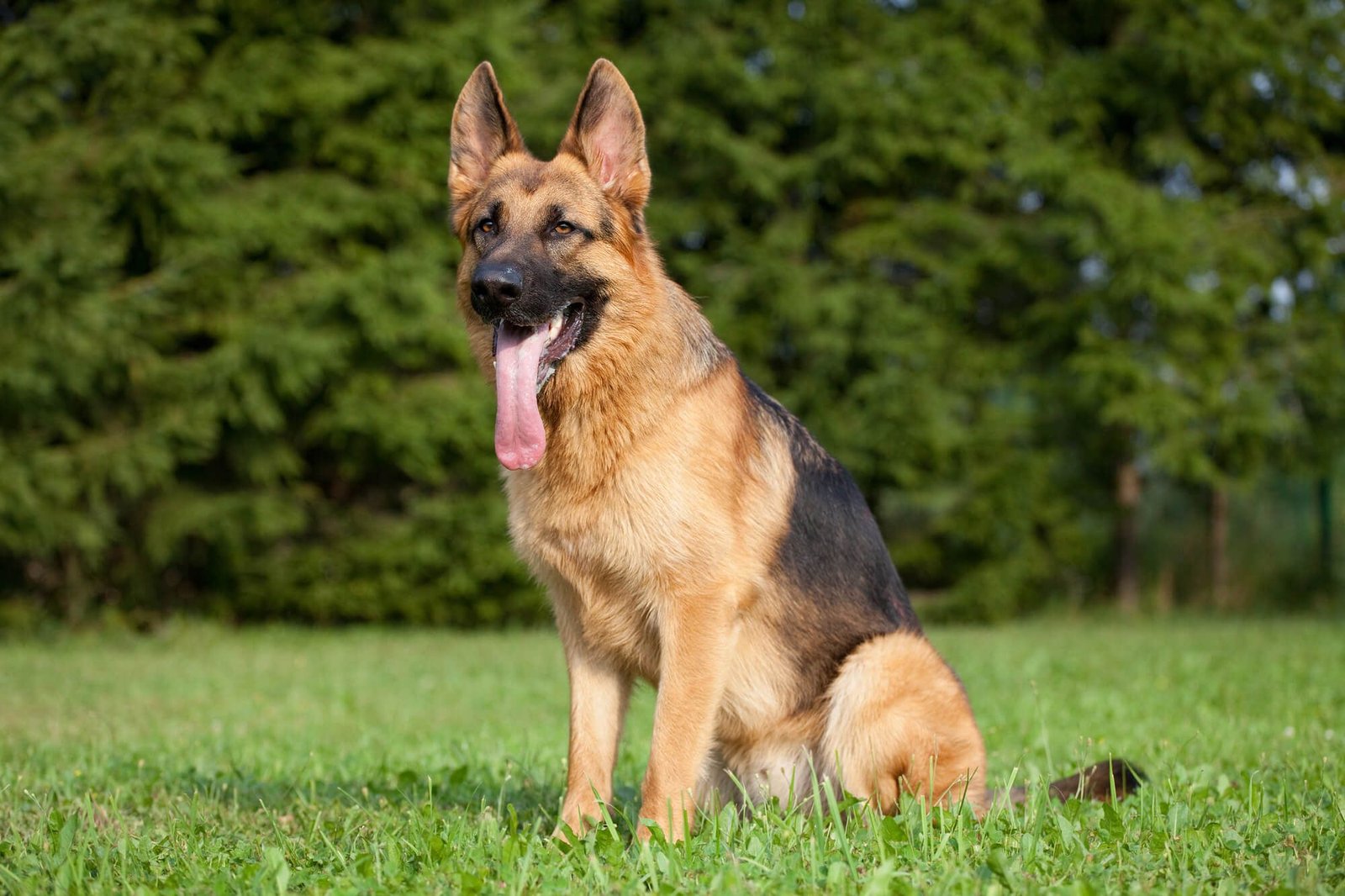
📢 This is Part 16 of the German Shepherd Series on DogsReader
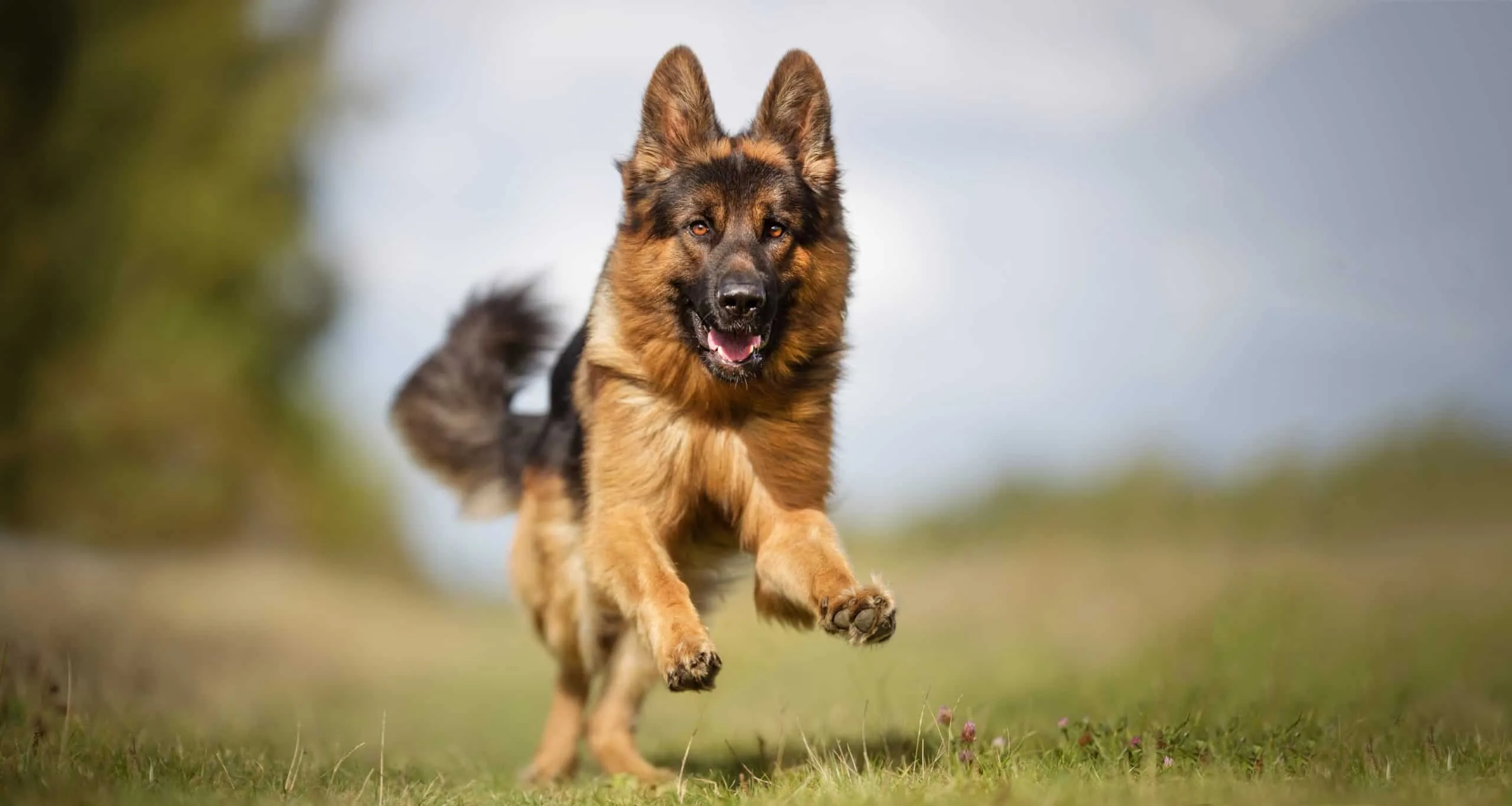
Explore all articles in the series to master the care, training, and development of the world’s most intelligent dog breed.
🐶 Visit: www.dogsreader.com
📩 Ask our 24/7 Dog Chatbot anything – trained with official AKC knowledge!
📧 Contact: dogsreaders@gmail.com
📱 Follow us on Facebook & Instagram
▶️ [Subscribe to us on YouTube | Facebook | Instagram |
🐾 Introduction: A German Shepherd’s Body is Built for Action
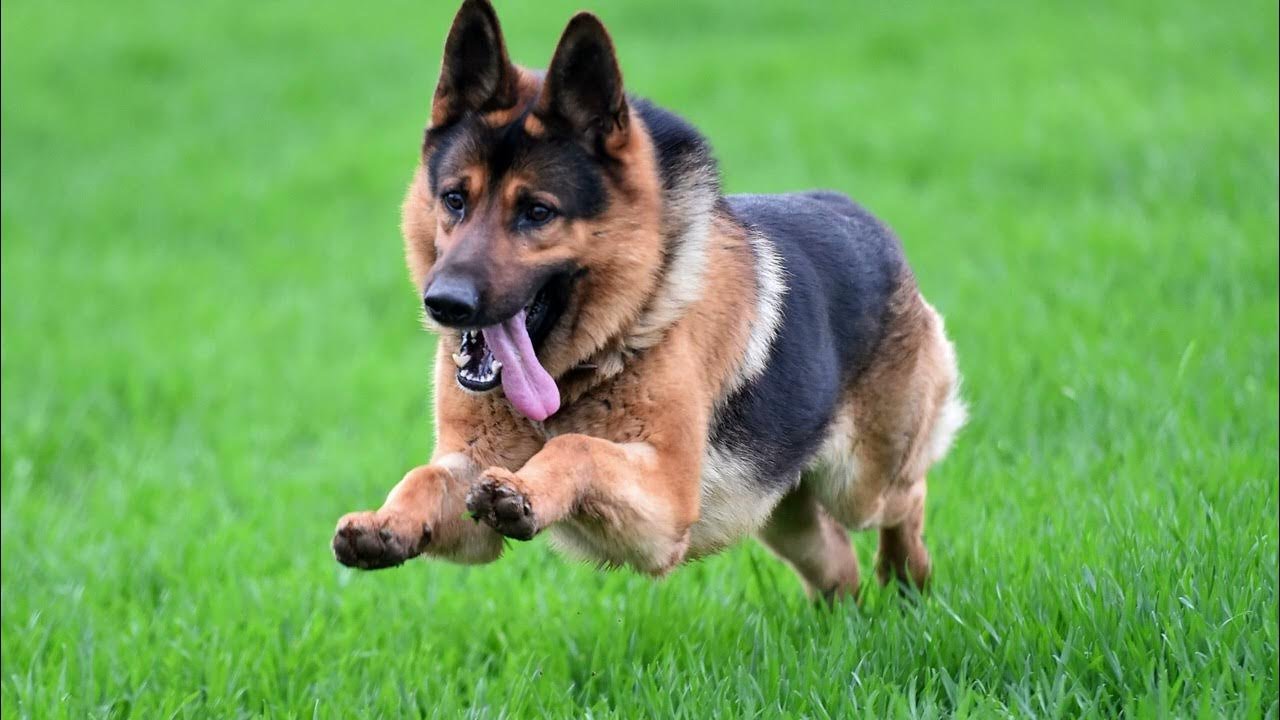
Introduction: The Power of Movement
German Shepherd Exercise Blueprint: The German Shepherd is not just a loyal family companion—it’s an athlete, protector, and thinker. Exercise is the fuel that powers their mental sharpness, physical strength, and emotional balance. However, not all German Shepherds need the same workout. Puppies, adults, and senior dogs have different exercise requirements, especially across varying weather conditions and global climates.
In this award-worthy article, we’ll break down optimal workouts by age and climate, and follow it with the ultimate post-exercise nutrition and supplement guide by country and season.
🐾 German Shepherd Puppy Exercise (0–12 Months)
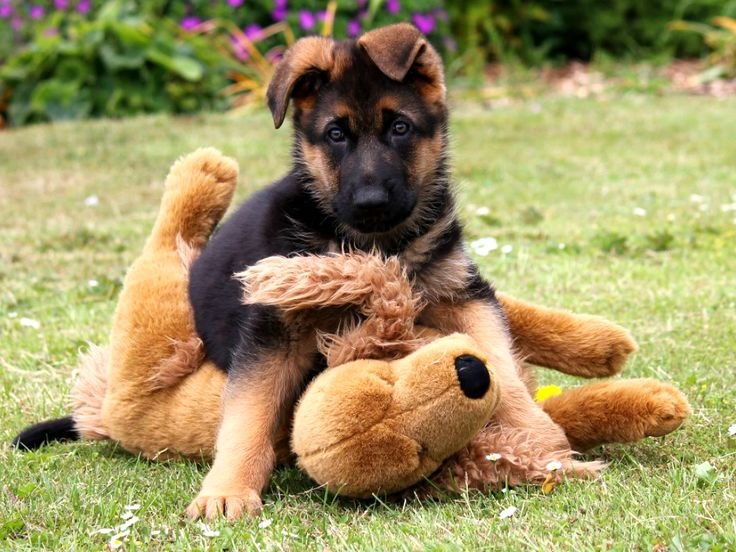
🧠 Key Focus:
- Growth-safe play
- Joint protection
- Controlled environments
🏋️♀️ Recommended Activities:
- 5 minutes per month of age ( 3-month-old = 15 mins)
- Leash walks (short, sniffing allowed)
- Puzzle toys and hide-n-seek
- Shallow water play
- Light incline climbing (grass hills)
🌍 Country/Climate Tips:
- Cold Winters (USA, Canada, Germany): Limit outdoor time. Use boots and coats. Try indoor games.
- Hot Summers (India, UAE, Mexico): Exercise early morning or post-sunset. Avoid pavement.
- Mild Climates (UK, Australia, Japan): Year-round outdoor walking/play. Monitor for growth spurts.
🐕 German Shepherd Adult Exercise (1–6 Years)
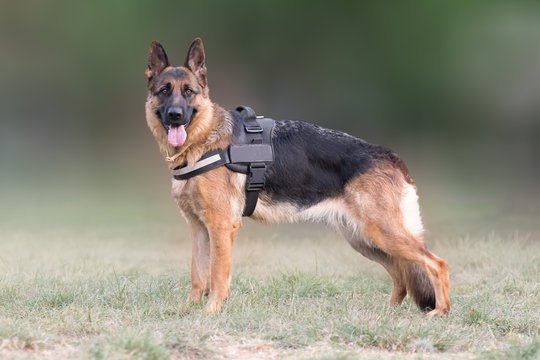
🧠 Key Focus:
- Peak physical condition
- Endurance + agility
- Daily consistency
Goal: Peak physical performance, mental resilience, and breed-appropriate challenge.
Daily Exercise Time:
90 to 120 minutes/day, divided between morning and evening
Recommended Activities:
-
Jogging & Running beside a bike (gradual start)
-
Tug Games with Resistance
-
Advanced Fetch & Ball-Launchers
-
Agility Training (A-frames, weave poles, tunnels)
-
Tracking & Scent Work
-
Swim Training (great joint protection)
-
Protection Training / Schutzhund-style Drills (with professionals)
-
Weighted Backpack Hikes (only after 18 months)
🎯 Mix 50% physical exercise + 50% mental stimulation for balance.
Country & Climate Adaptations:

🌞 Hot Countries:
-
Schedule workouts early (before 9am) or post-sunset.
-
Prioritize shade and water.
-
Swimming is ideal!
❄️ Cold Regions:
-
Use padded gear for long treks.
-
Snow fetch is fun—but watch for ice cuts.
-
Indoor treadmill sessions for heavy snow days.
🌧 Rainy Zones:
-
Indoor agility and stair workouts.
-
Rotate with treat puzzles, hide-and-seek games, and obedience drills.
German Shepherd Senior Exercise (7+ Years)
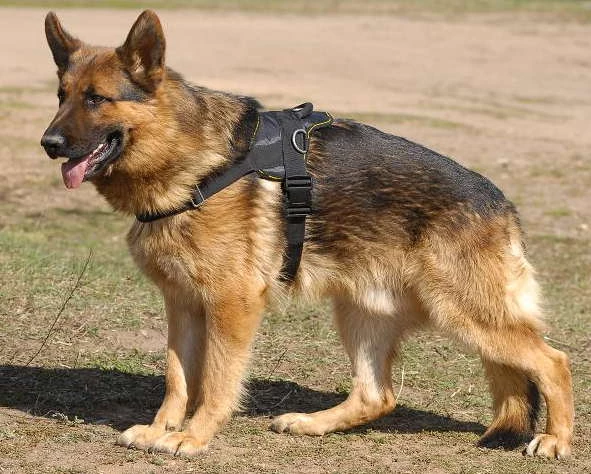
🧠 Key Focus:
- Joint health
- Low-impact movement
- Mental stimulation
Goal: Preserve muscle tone, joint health, and cognitive sharpness.
Daily Exercise Time:
30 to 45 minutes, broken into low-impact sessions
Best Activities:
-
Leisure Walks with Scent Exploration
-
Hydrotherapy (underwater treadmills, pool swims)
-
Stretching & Balance Exercises
-
Slow Obstacle Walks
-
Basic Training Refresher Commands
-
Massage & Range-of-Motion Routines
💡 Keep it low-impact. Avoid stairs, jumping, or heavy pulling. Joint supplements like glucosamine are strongly recommended.
Climate Considerations:
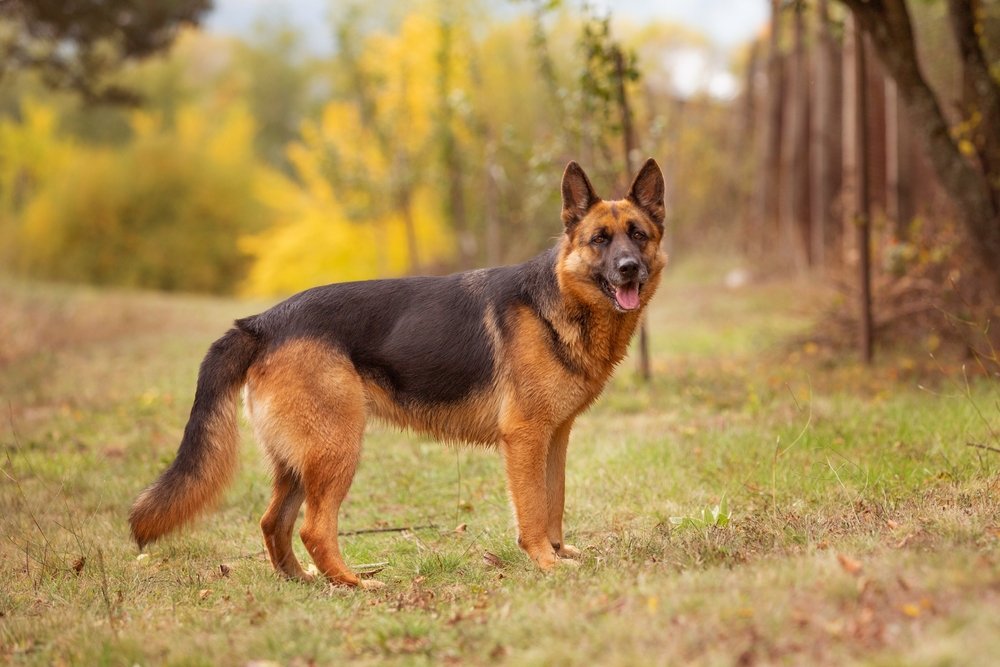
-
Cold weather: Use orthopedic beds, warm coats, and paw balm.
-
Hot weather: Walk during coolest times of the day, ensure constant hydration.
-
Rainy zones: Soft indoor mats for traction; mental games for enrichment.
🗺️ Country-Wise Lifestyle Customization
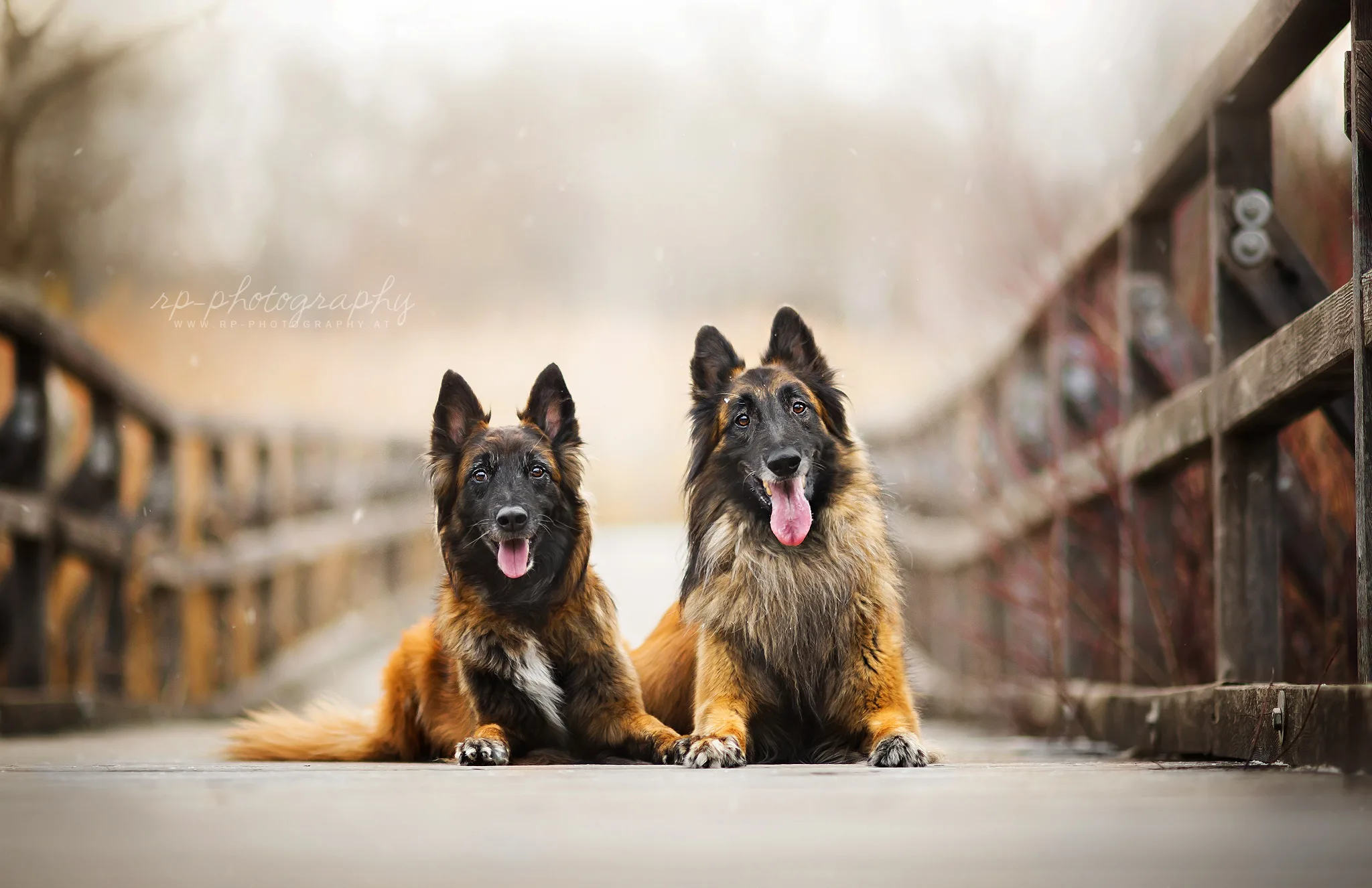
| Country | Climate Type | Best Exercise Options |
|---|---|---|
| USA | Varies (state-wise) | Hiking, park fetch, seasonal agility |
| Canada | Cold | Snow play, indoor scent games, treadmill work |
| India | Hot/Humid | Early walks, indoor games, short leash runs |
| Germany | Moderate | Urban trekking, forest walks, Schutzhund |
| Australia | Hot & Dry | Beach runs, evening jogs, obstacle play |
| UK | Rainy/Cool | Indoor obstacle courses, ball play, park walks |
| UAE | Desert Heat | Pool swims, climate-controlled training centers |
⚠️ Common Mistakes to Avoid
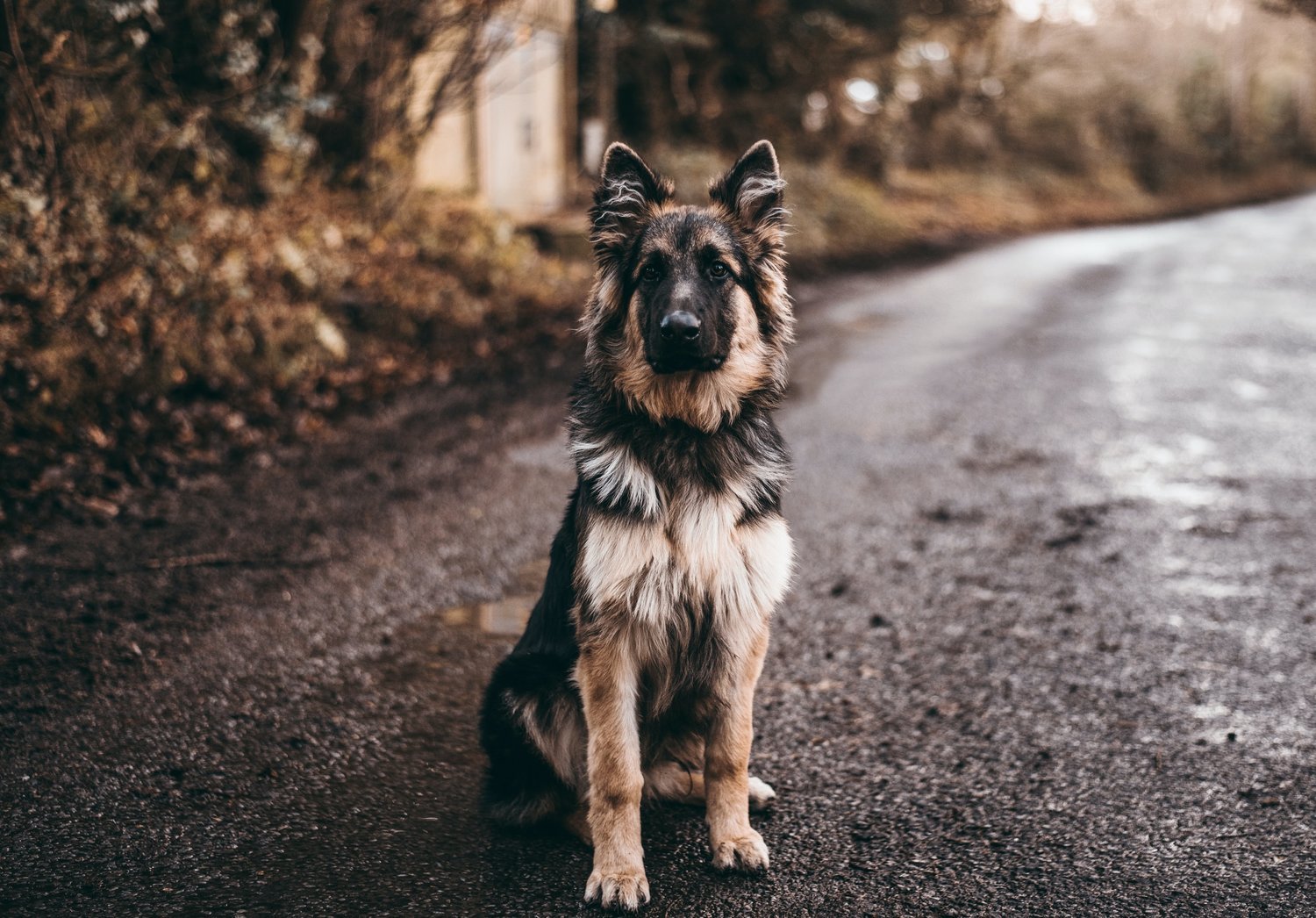
-
Overexercising puppies or seniors
-
Ignoring climate risks (heatstroke, hypothermia)
-
Not varying routines—boredom = behavior problems
-
Exercising immediately after meals
-
Skipping warm-ups and cool-downs
🎖 Pro Tip: Weekly Rotation Chart (Sample)
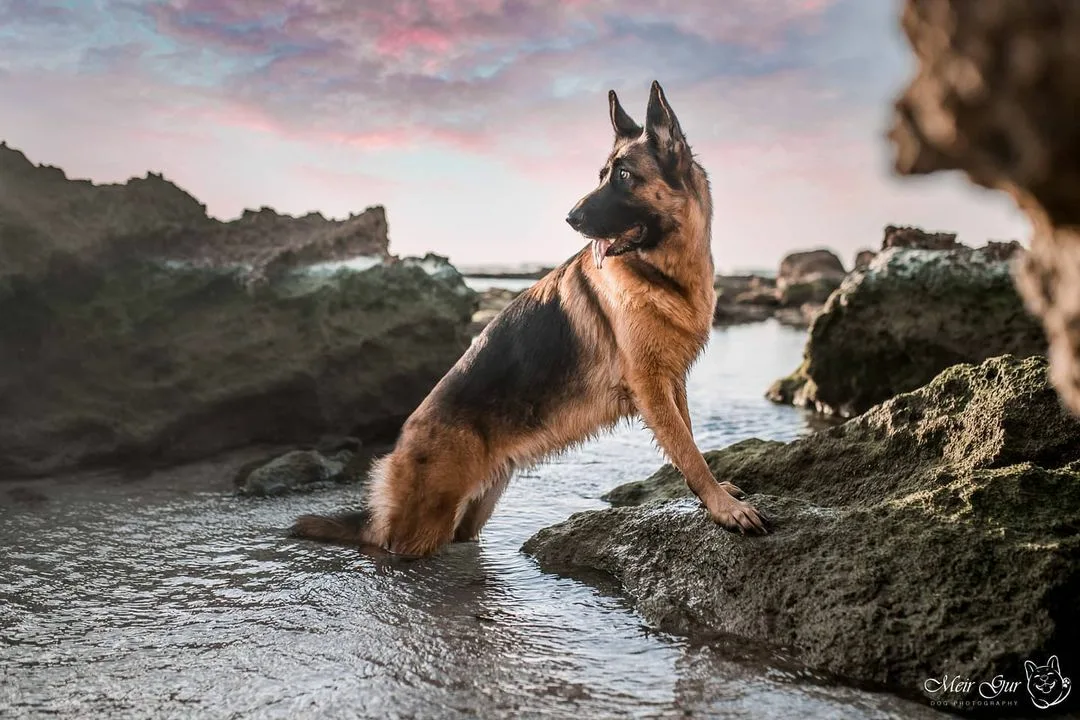
| Day | Activity Mix |
|---|---|
| Monday | Obedience + Scent work |
| Tuesday | Jog + Agility + Fetch |
| Wednesday | Off-leash Trail Hike |
| Thursday | Rest day + Puzzle Games |
| Friday | Tracking Game + Basic Commands Review |
| Saturday | Long Walk + Park Socialization |
| Sunday | Tug Game + Brain Toy Challenge |
🧠 Exercise is a Lifetime Contract
From puppy play to senior strolls, exercise isn’t just about energy release—it’s about mental health, bonding, and unlocking the legendary potential of the German Shepherd. Adapt to their age, adjust to your country, and stay consistent.
A tired German Shepherd is a happy, well-behaved one.
🥩 Post-Exercise Nutrition & Supplements by Age, Season, and Region

📊 Country-Wise + Seasonal Nutrition Table
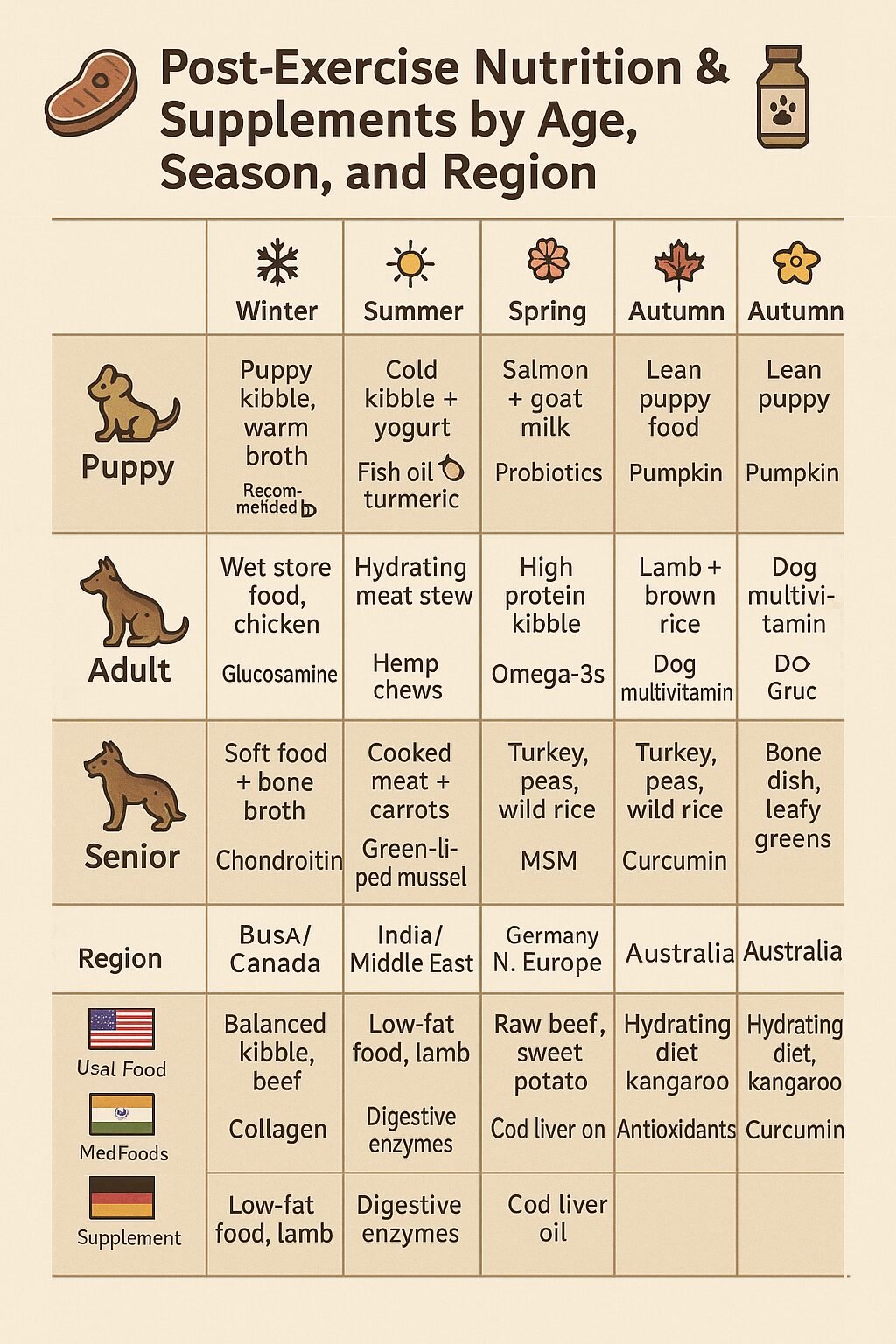
Click Any Picture To Buy From Amazon
| Life Stage | Season | Countries | Ideal Foods Post Exercise | Recommended Supplements |
|---|---|---|---|---|
| Puppy | Winter | USA, Germany, Canada | Warm broth over high-protein kibble | Fish oil,
|
| Summer | India, UAE, Mexico | Cold goat milk, puppy biscuits, chicken & rice | Probiotics,
|
|
| Spring | UK, Japan, France | Raw-fed mix or soft meat blend | DHA,
|
|
| Autumn | USA, Australia, Europe | High-calorie puppy mash | Digestive enzymes,
|
|
| Adult | Winter | Russia, Canada, USA | Lamb, brown rice, steamed veggies | Glucosamine, Omega-3s, Multivitamin |
| Summer | Brazil, India, UAE | Lean fish, quinoa, pumpkin | Electrolytes, Joint support
|
|
| Spring | USA, UK, Australia | Chicken, oats, carrots | Liver tonic,Taurine
|
|
| Autumn | Germany, France, Japan | Beef stew, boiled egg | Vitamin B complex,
|
|
| Senior | Winter | Canada, Poland, Norway | Soft turkey or salmon, mashed sweet potato | Joint formula, Turmeric
|
| Summer | India, UAE, Mexico | Cold cottage cheese, papaya cubes | Probiotics,
|
|
| Spring | UK, Japan, USA | Chicken broth soup with rice | Ginseng, Eye health blend, Anti-inflammatory herbs | |
| Autumn | France, Germany, Spain | Softened kibble, sardines | Bone density mix,
|
💡 Always offer fresh water post-exercise and wait 30–45 minutes before feeding to prevent bloating in deep-chested breeds like the German Shepherd.
Closing Statement: The Body Fuels the Mind
Your German Shepherd’s physical routine should evolve with time, age, climate, and geography. By tuning into their changing needs and pairing exercise with proper nutrition, you not only extend their life—you enhance their spirit. Whether bounding through snow or strolling in spring rain, your GSD thrives when the body and mind move in harmony.
📌 Frequently Asked Questions (FAQs)
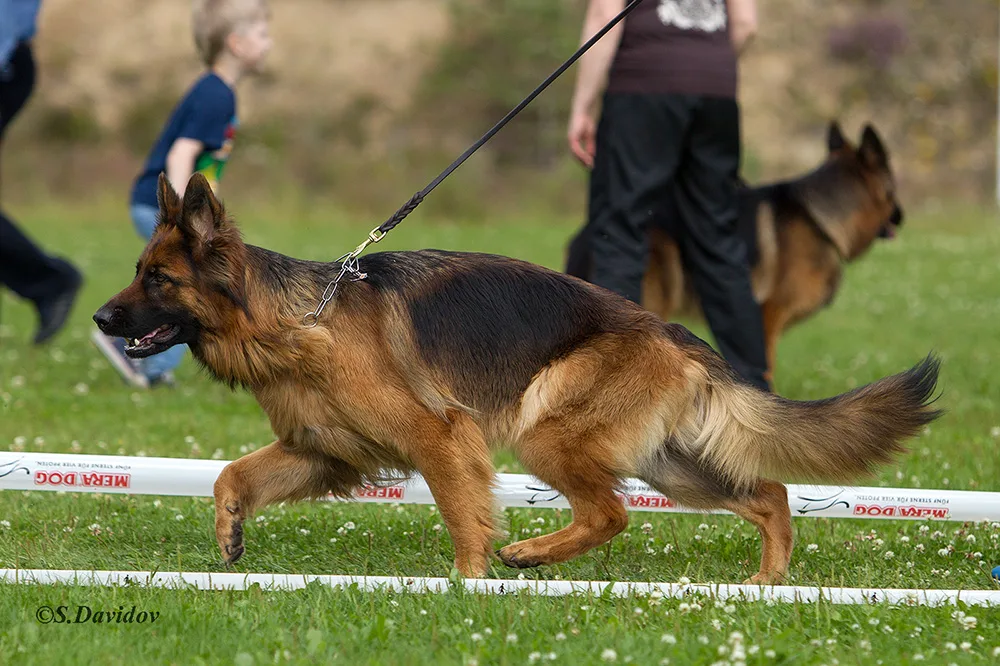
❓ How much exercise does a German Shepherd puppy need?
A German Shepherd puppy should follow the “5-minute rule” — 5 minutes of exercise per month of age, up to twice a day. For example, a 4-month-old puppy should get 20 minutes of light, controlled activity twice daily.
❓ Can I over-exercise my German Shepherd?
Yes, over-exercising can harm joints, especially in puppies and senior dogs. Always tailor workouts based on your dog’s age, health, and weather conditions.
❓ What are the best exercises for a senior German Shepherd?
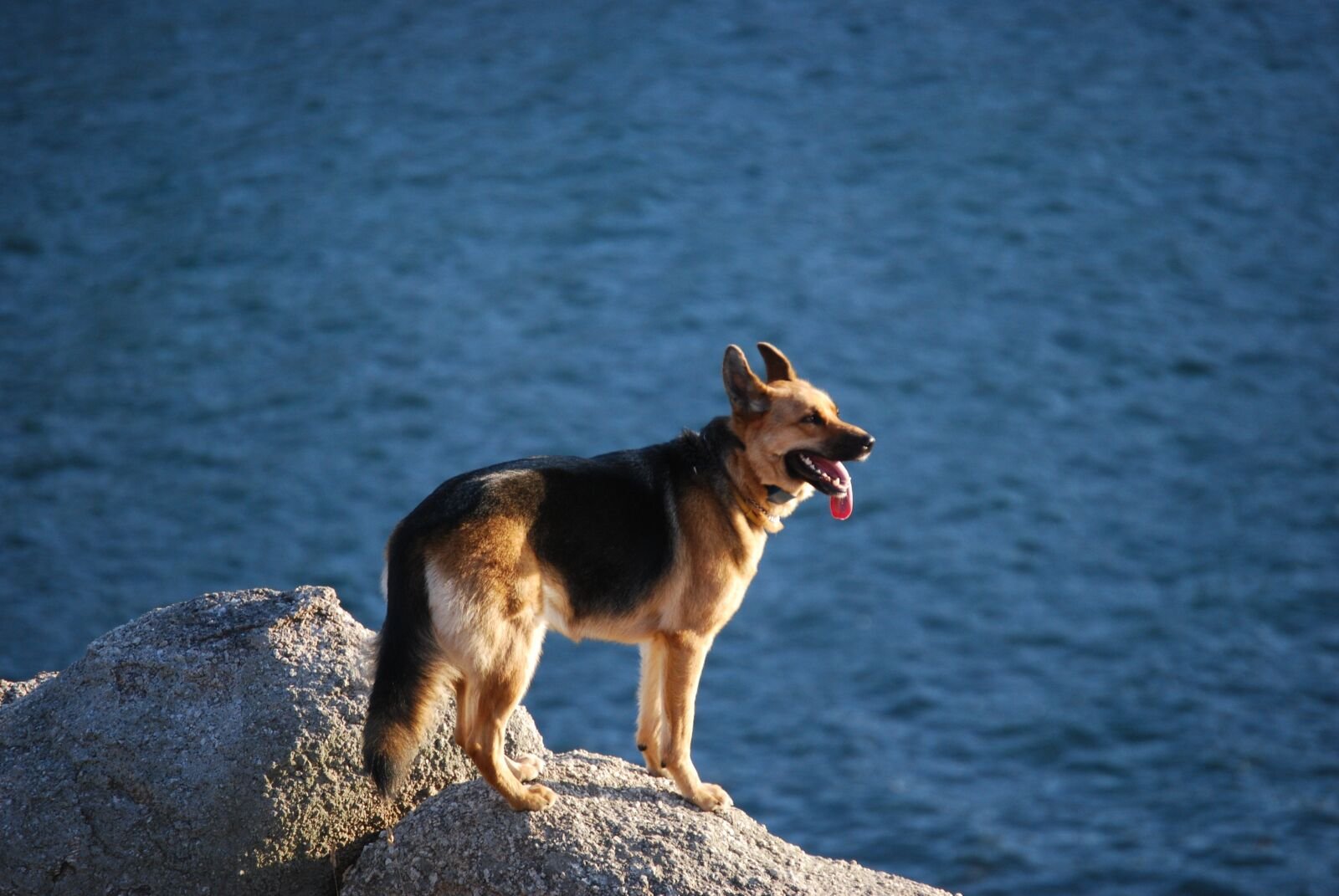
Low-impact activities like walking on soft ground, swimming, and mental enrichment games (e.g., treat puzzles or nose work) are ideal for seniors to maintain health without stressing joints.
❓ Are there different exercises for German Shepherds in hot vs. cold climates?
Absolutely. In hot climates, focus on swimming, early morning walks, and shaded play. In cold climates, use coats and booties and try indoor games or snow walks if safe.
❓ What’s the ideal post-exercise diet for a German Shepherd?
Post-exercise meals should be given 30–45 minutes later to avoid bloat. Focus on lean protein, moderate carbs, and supplements based on age and season—like joint support for seniors or probiotics in summer.
❓ Do German Shepherds need different exercises based on country or region?
Yes. Factors like humidity, temperature, and terrain impact your dog’s energy needs. For instance, sled pulling works in snowy Canada, while shaded trail hikes suit tropical regions like India or Brazil.
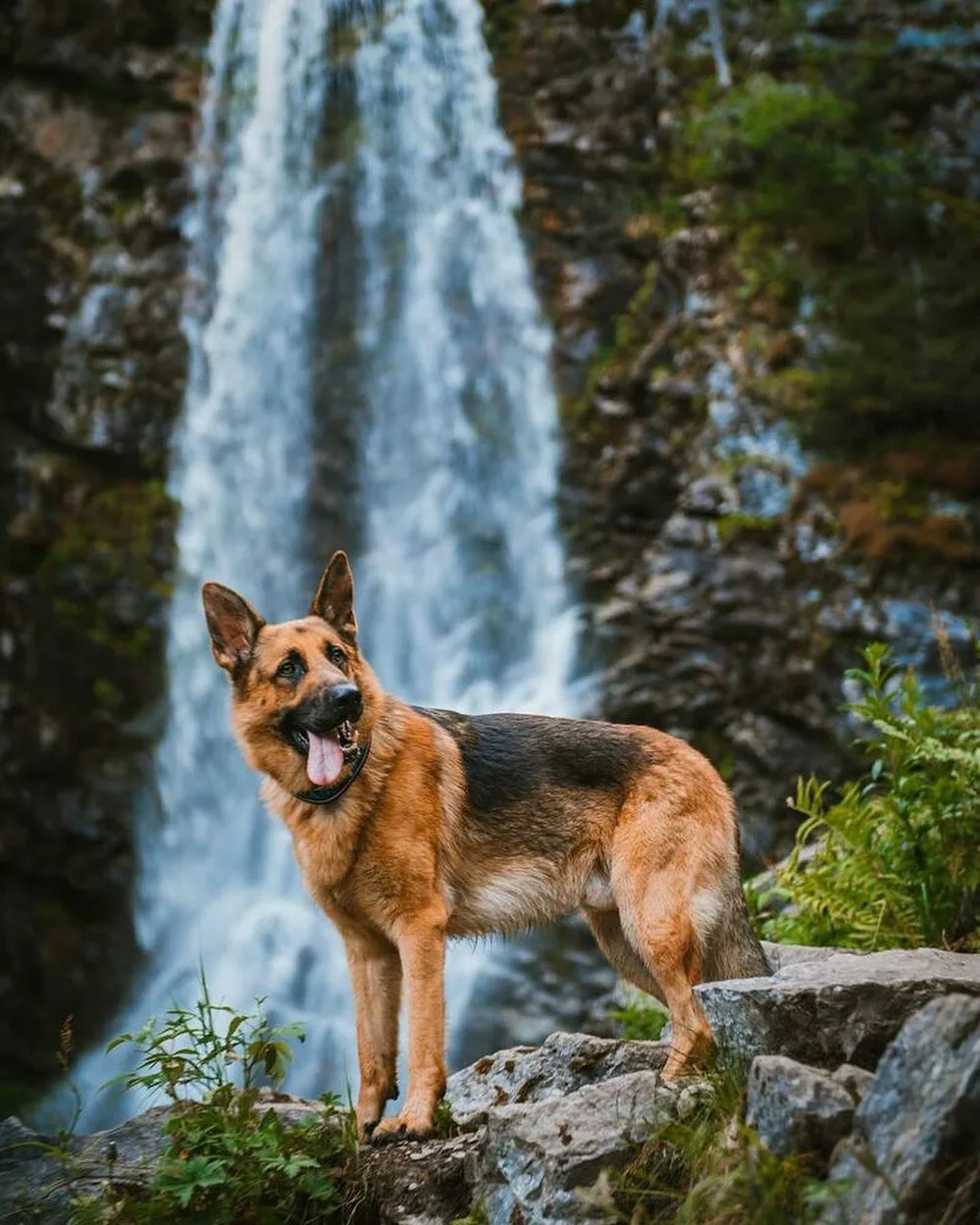
Working Breeds
German Shepherd Training Unleashed: Full Command Control for Real-World Brilliance
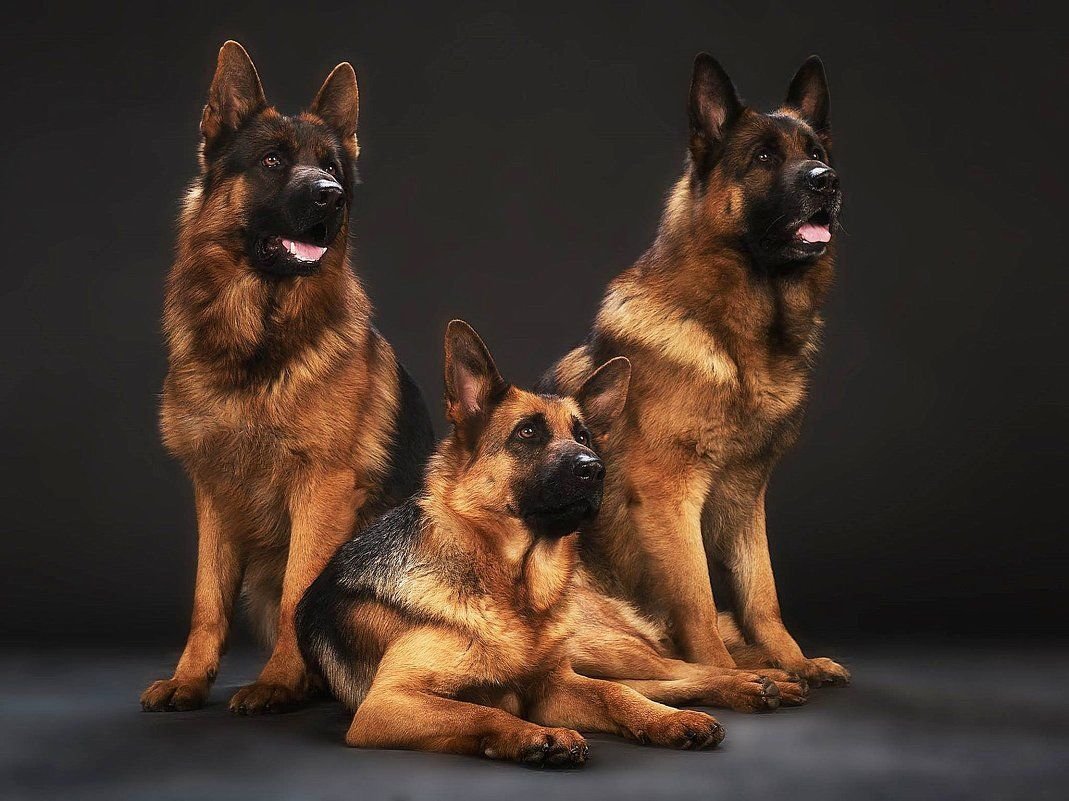
📢 This is Part 15 of the German Shepherd Series on DogsReader

Explore the full series and gain expert insights into one of the world’s most intelligent breeds.
🐶 Visit: www.dogsreader.com
📩 Ask our 24/7 Dog Chatbot anything – trained with official AKC knowledge!
📧 Contact: dogsreaders@gmail.com
📱 Follow us on Facebook & Instagram
▶️ [Subscribe to us on YouTube | Facebook | Instagram |
Introduction: Beyond Sit and Stay
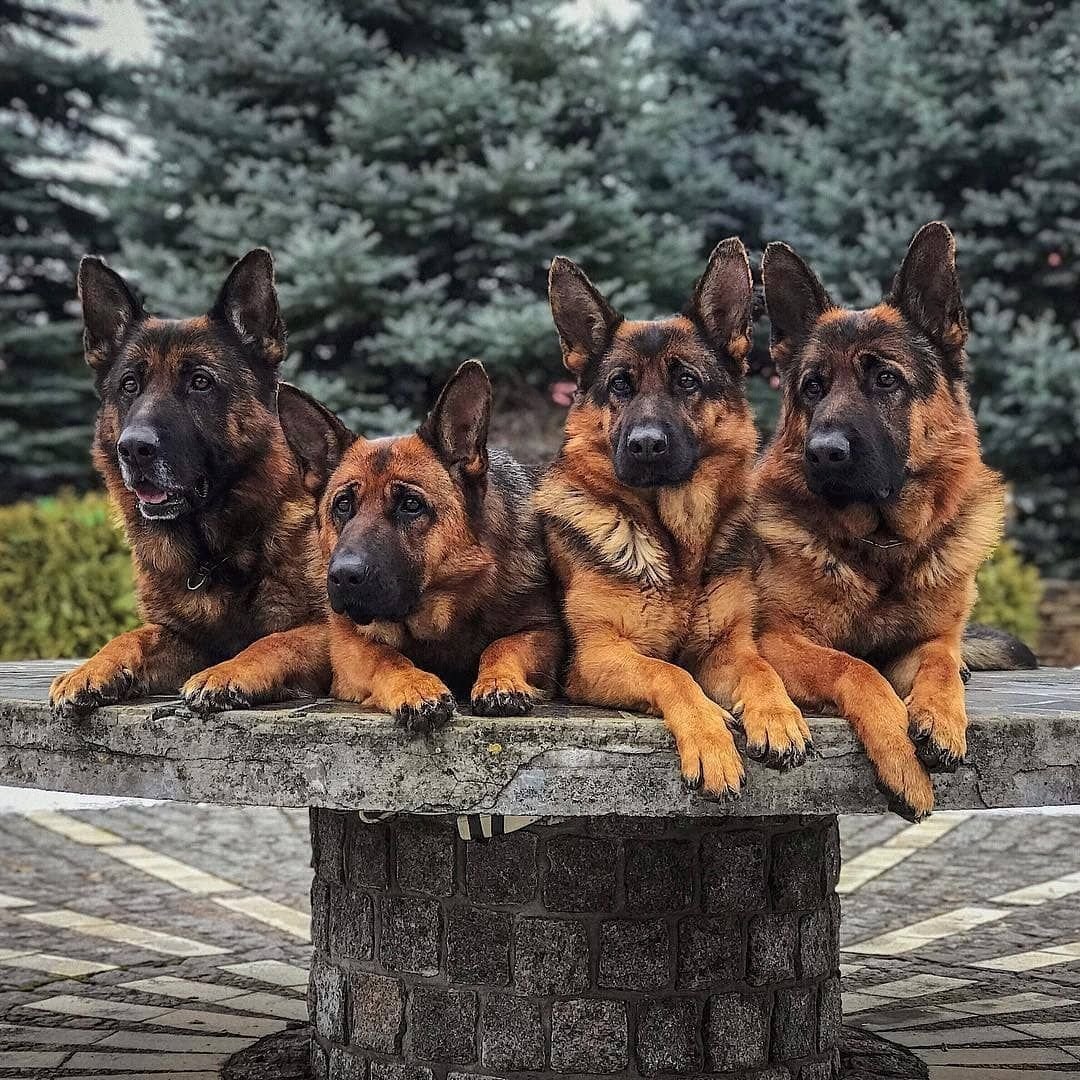
German Shepherd Training Unleashed: German Shepherds aren’t just dogs – they’re highly capable partners in action. With their sharp minds, drive to learn, and desire to please, these dogs are engineered for excellence. Whether you’re training for obedience, protection, or working roles, mastering the right commands can transform your German Shepherd into a true champion.
In this article, we guide you through the essential, intermediate, and advanced command stages to unlock your German Shepherd’s full working potential.
1. Understanding Command Training Philosophy

Before diving into the actual commands, it’s important to grasp the mindset of the German Shepherd:
- They thrive on structure.
- They bond deeply with their trainer.
- They excel with consistency and challenge.
Whether it’s a family environment or a police academy, the foundational training principle remains the same: clear leadership, positive reinforcement, and purposeful progression.
2. Basic Obedience Commands (Foundation Stage)
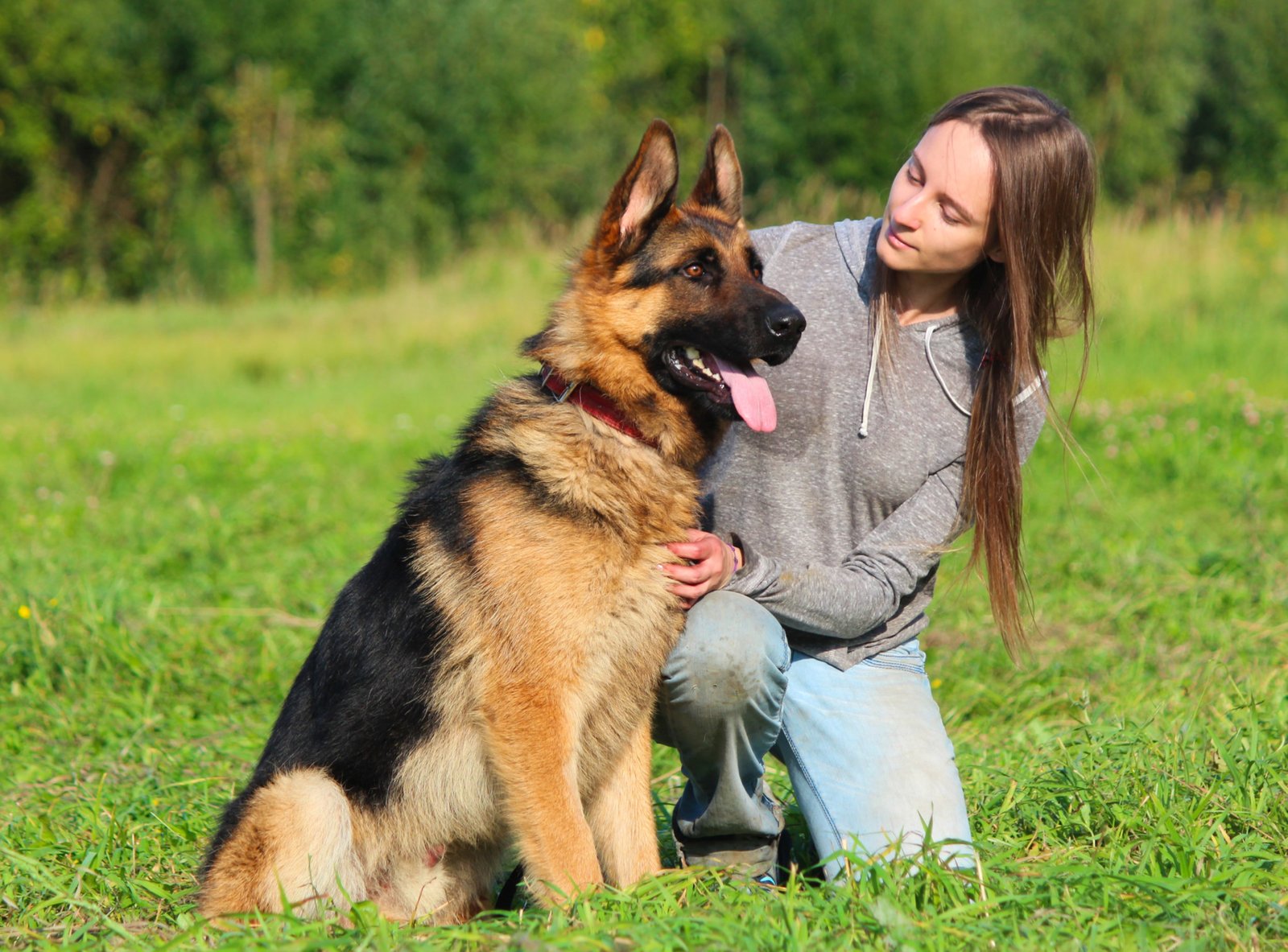
These form the groundwork for all future training:
- Sit
- Stay
- Come
- Down
- Heel
- Leave it
- No
These commands should be taught with:
- Short daily sessions
- Positive reward systems (treats, praise, or toy)
- Clear voice tones and consistent gestures
🧠 Pro Tip: Teach hand signals with each verbal cue to reinforce long-distance control.
3. Intermediate Working Commands (Real-World Integration)
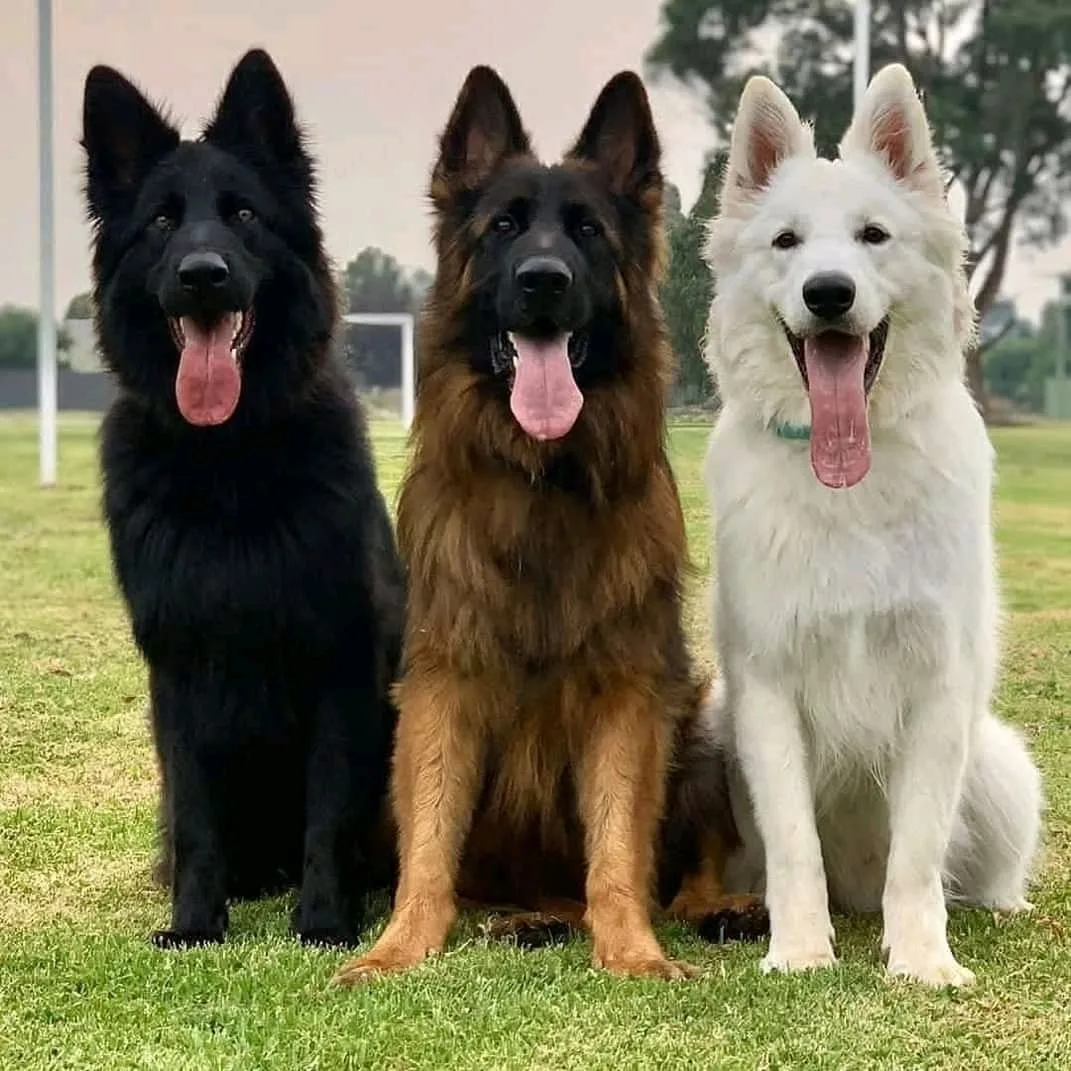
Once your dog masters the basics, they’re ready for more complex and practical training:
- Wait (Useful for doors, vehicles, food bowls)
- Watch me (For focus in high-distraction areas)
- Place (Go to a specific location and stay)
- Back up (Create space on command)
- Take it / Drop it (Retrieve or release items)
- Speak / Quiet (Controlled barking – excellent for alert or protection dogs)
These commands increase control and mental stimulation while preparing your dog for either professional duties or elevated home discipline.
4. Advanced Commands (Working & Professional Environments)

These are tailored for dogs being trained as K9 units, military dogs, service dogs, or high-discipline family companions:
- Search (Find a person or item)
- Track (Follow scent)
- Guard (Take protective stance)
- Bite / Release (Used in police or protection training only under professional guidance)
- Escort / Block (Walk beside or prevent others from approaching)
- Silent Commands (Training via signals alone)
📌 Important: Advanced commands must be taught with precision and care. In protection work, always consult a professional trainer to avoid behavioral risks.
5. Command Drills: Keeping Your German Shepherd Sharp

Repetition keeps your GSD engaged and responsive. Here are suggested drills:
- Command Chain Training (Link 3-5 commands in succession)
- Distraction Drills (Train in parks, busy areas, or with other dogs around)
- Distance Recall Challenges (Test “Come” command from long distances)
- Obstacle Work (Combine physical tasks with commands: sit on platform, jump, stay)
💡 Weekly refreshers keep even senior German Shepherds mentally young.
6. Common Training Mistakes to Avoid
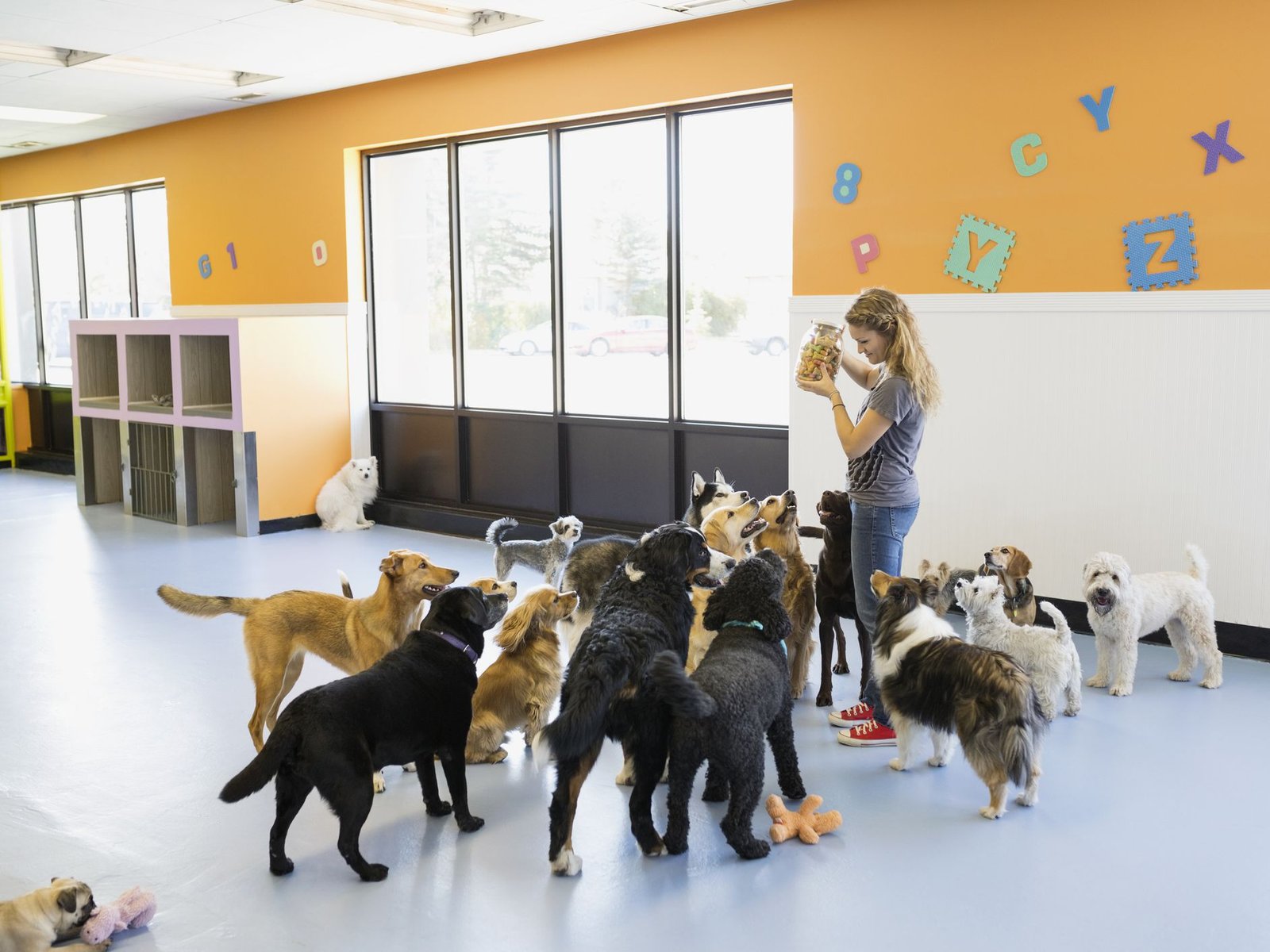
- Mixing up commands
- Changing tone inconsistently
- Training while distracted or frustrated
- Over-rewarding or confusing the reward timing
- Using punishment instead of correction
📣 Consistency + Patience = Success
7. Creating Your Own Custom Command List
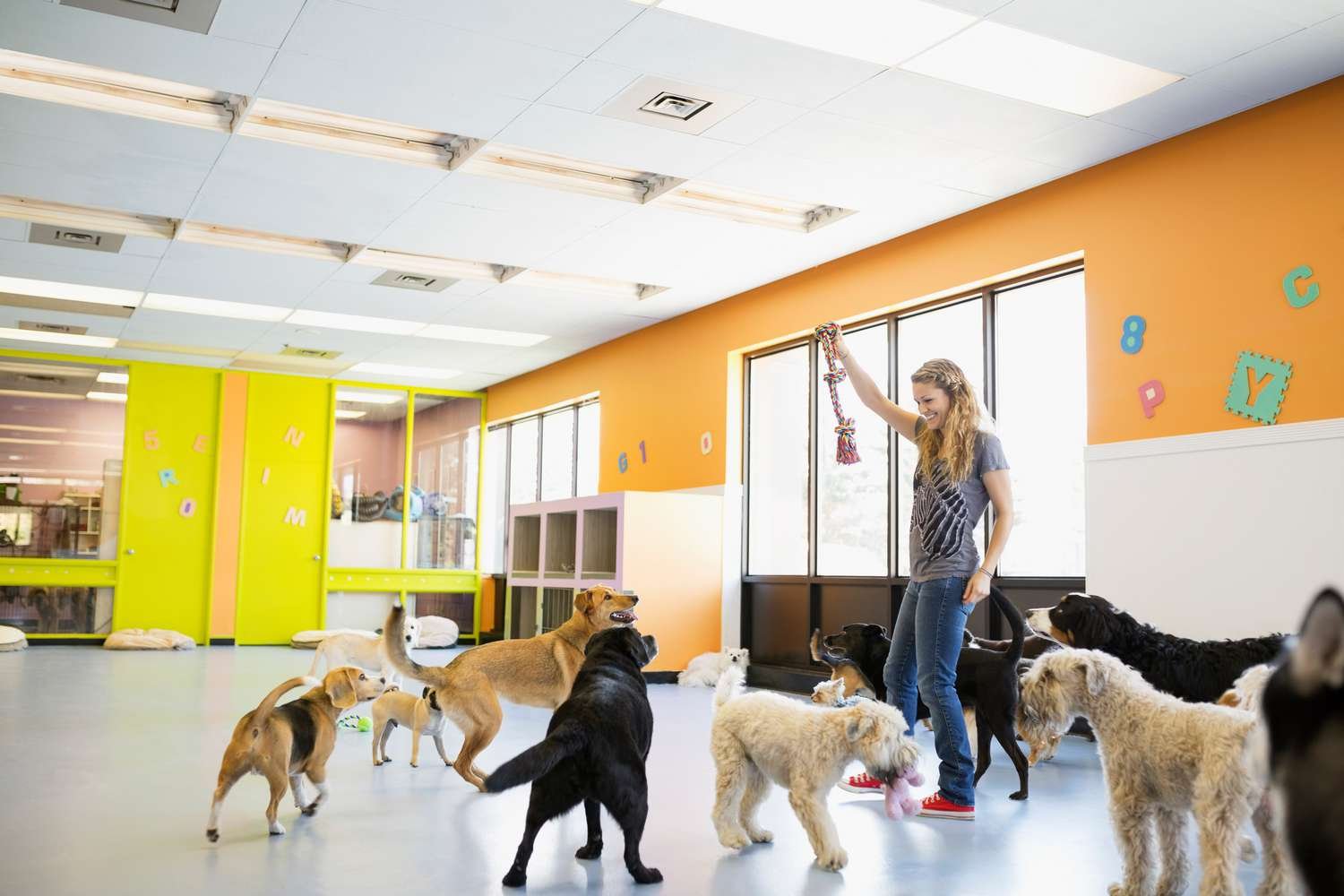
You can personalize your GSD’s command set to suit your lifestyle:
- “Go get the leash”
- “Turn off the light”
- “Find [name]”
- “Get the keys”
The key is to connect action with reward and keep commands short and clear.
Closing Statement : A Dog That Thinks Before Acting
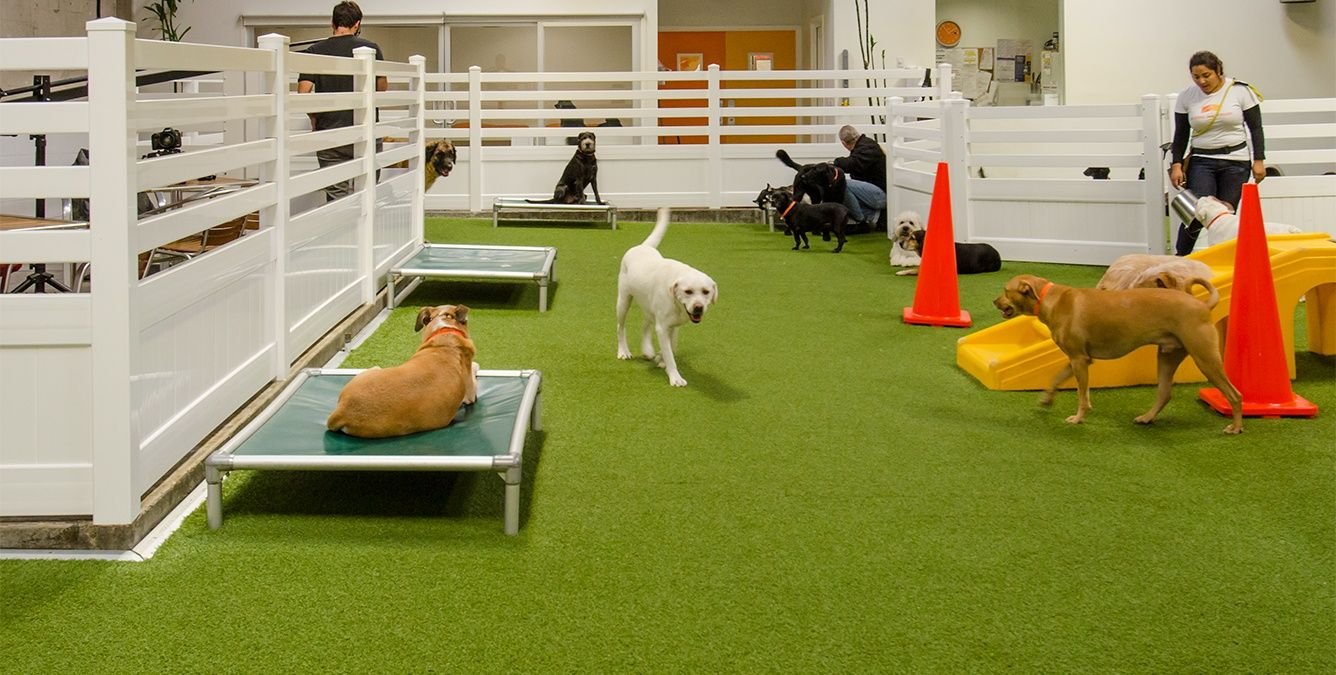
When trained well, a German Shepherd doesn’t just follow commands – they anticipate them. You’re not just raising a pet; you’re raising a partner. Through discipline, consistency, and love, your German Shepherd can achieve a level of intelligence and control few breeds can match.
Stay tuned for Part 16 in the German Shepherd Series, only on DogsReader.
🐾 Frequently Asked Questions – Mastering Commands: German Shepherd Training

1. What are the most important commands every German Shepherd should know?
Basic commands such as Sit, Stay, Come, Heel, Down, and No are essential for obedience. Intermediate and advanced commands like Search, Guard, Track, and Silent Commands help unlock their full working potential.
2. At what age should I start command training for my German Shepherd?
You can begin basic command training as early as 8 weeks old using positive reinforcement. More advanced training should wait until the dog is physically and mentally ready, around 6 months and older.
3. How long does it take to train a German Shepherd in commands?
Most German Shepherds grasp basic commands in 2–4 weeks with consistent training. Advanced command mastery for working purposes may take several months to a year, depending on the dog and trainer’s experience.
4. Can German Shepherds learn commands in multiple languages?
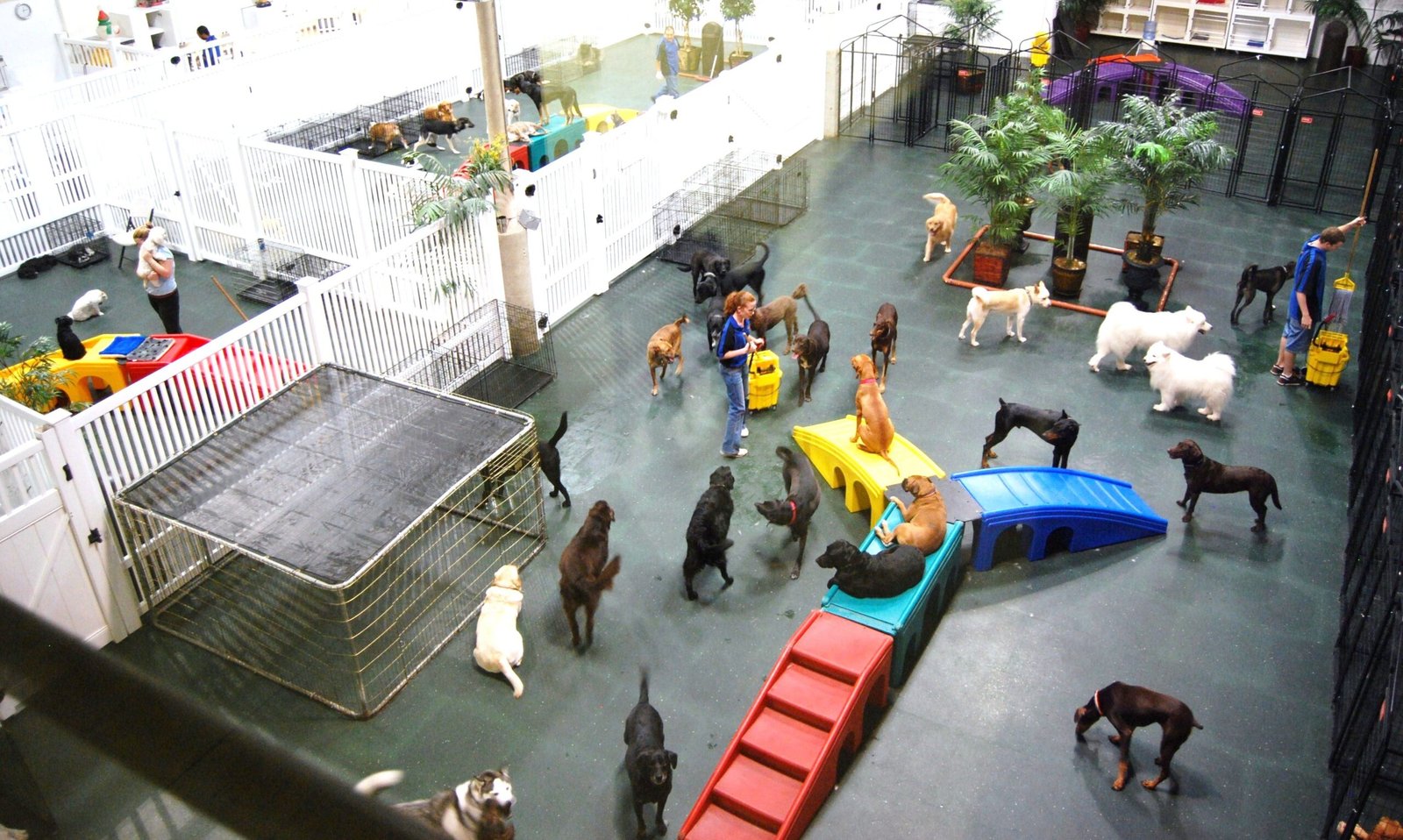
Yes, German Shepherds can learn commands in any language, including German, English, or hand signals. Many working dogs are trained in German to avoid confusion in public environments.
5. What’s the difference between obedience and working dog commands?
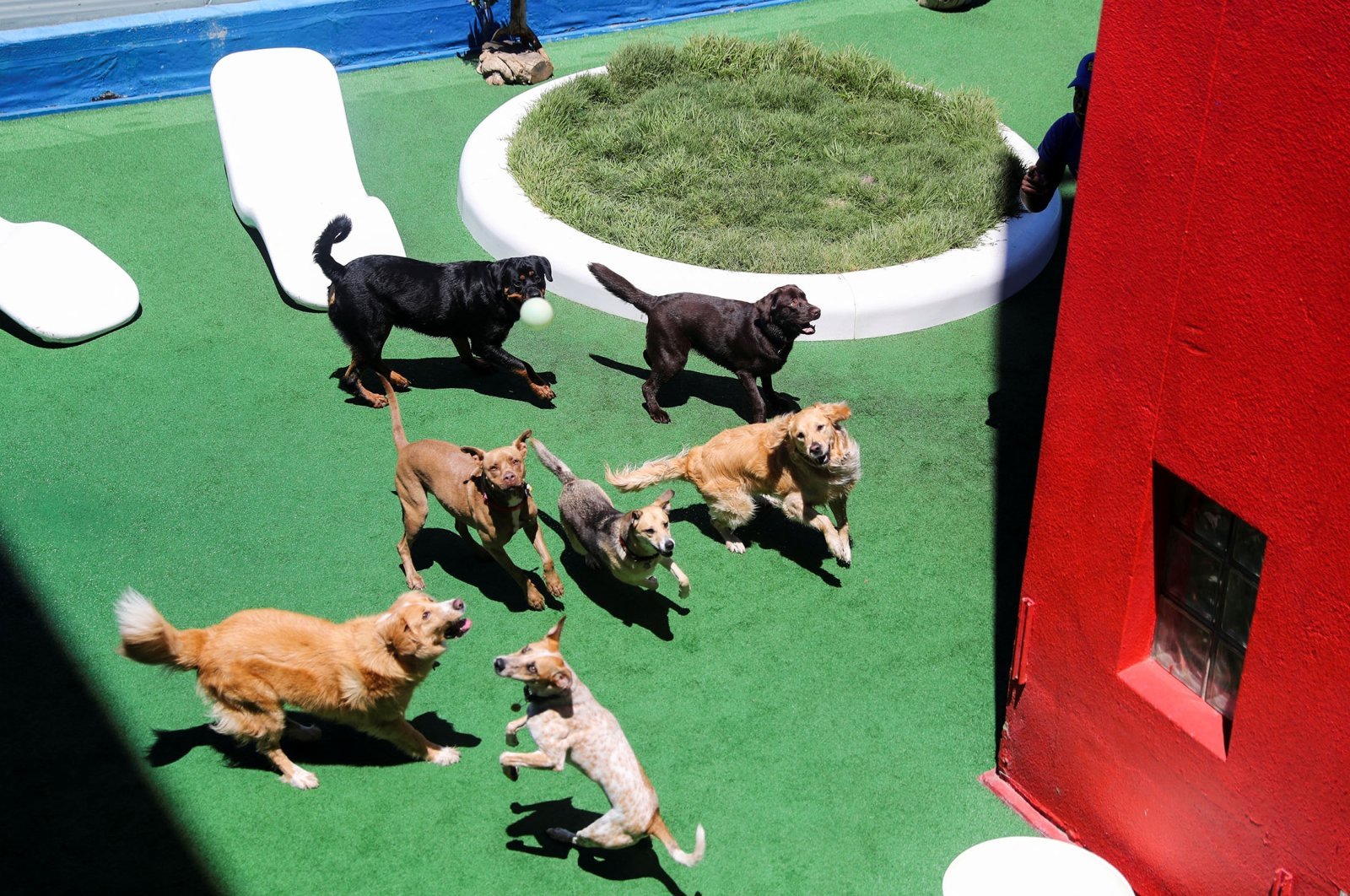
Obedience commands are for home behavior and safety (like Sit or Stay). Working dog commands include advanced instructions like Track, Guard, Search, and Bite/Release used in police, military, or service dog roles.
6. Should I use hand signals or verbal cues when training?
Ideally, you should use both hand signals and verbal cues during training. This ensures your German Shepherd understands commands visually and audibly, which is especially helpful in loud or distracting environments.
7. Can an older German Shepherd still learn new commands?
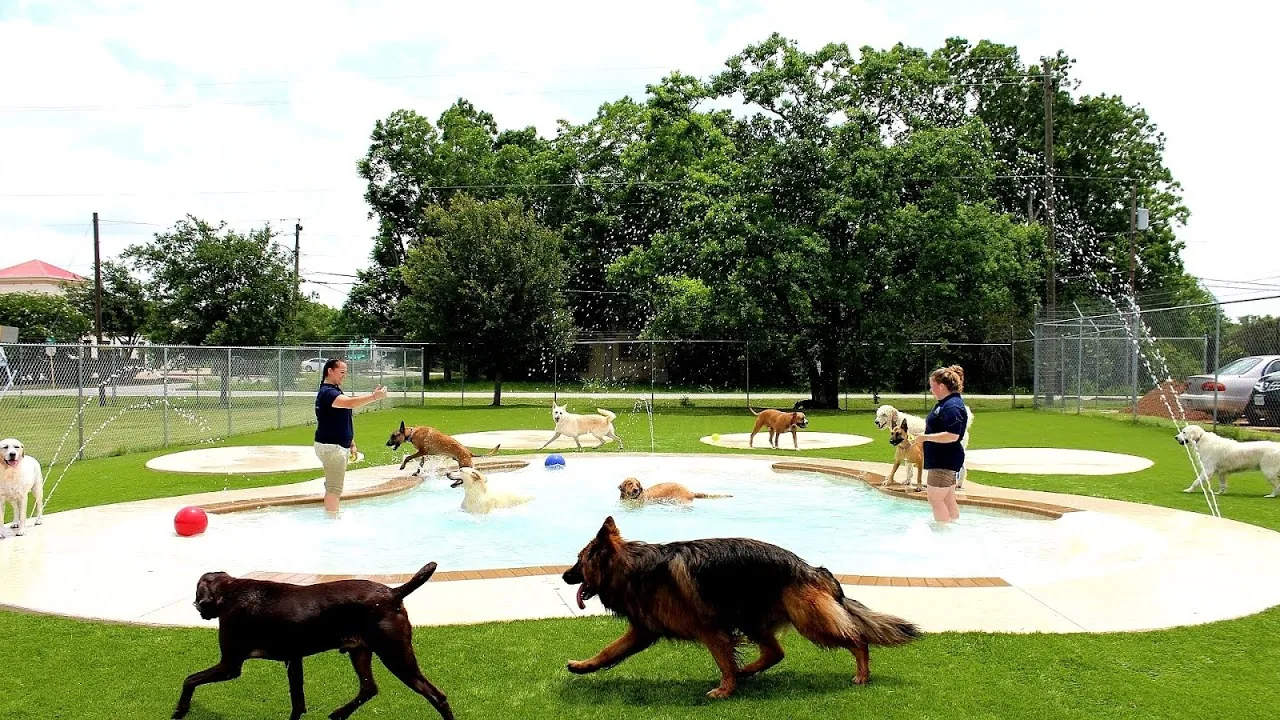
Absolutely. German Shepherds are highly intelligent at any age. While puppies learn faster, adult and senior dogs can still be trained effectively with the right approach and consistency.
8. Are German Shepherds good at remembering commands long-term?
Yes, German Shepherds have exceptional memory retention when trained properly. They can remember commands for months or even years with periodic refreshers.
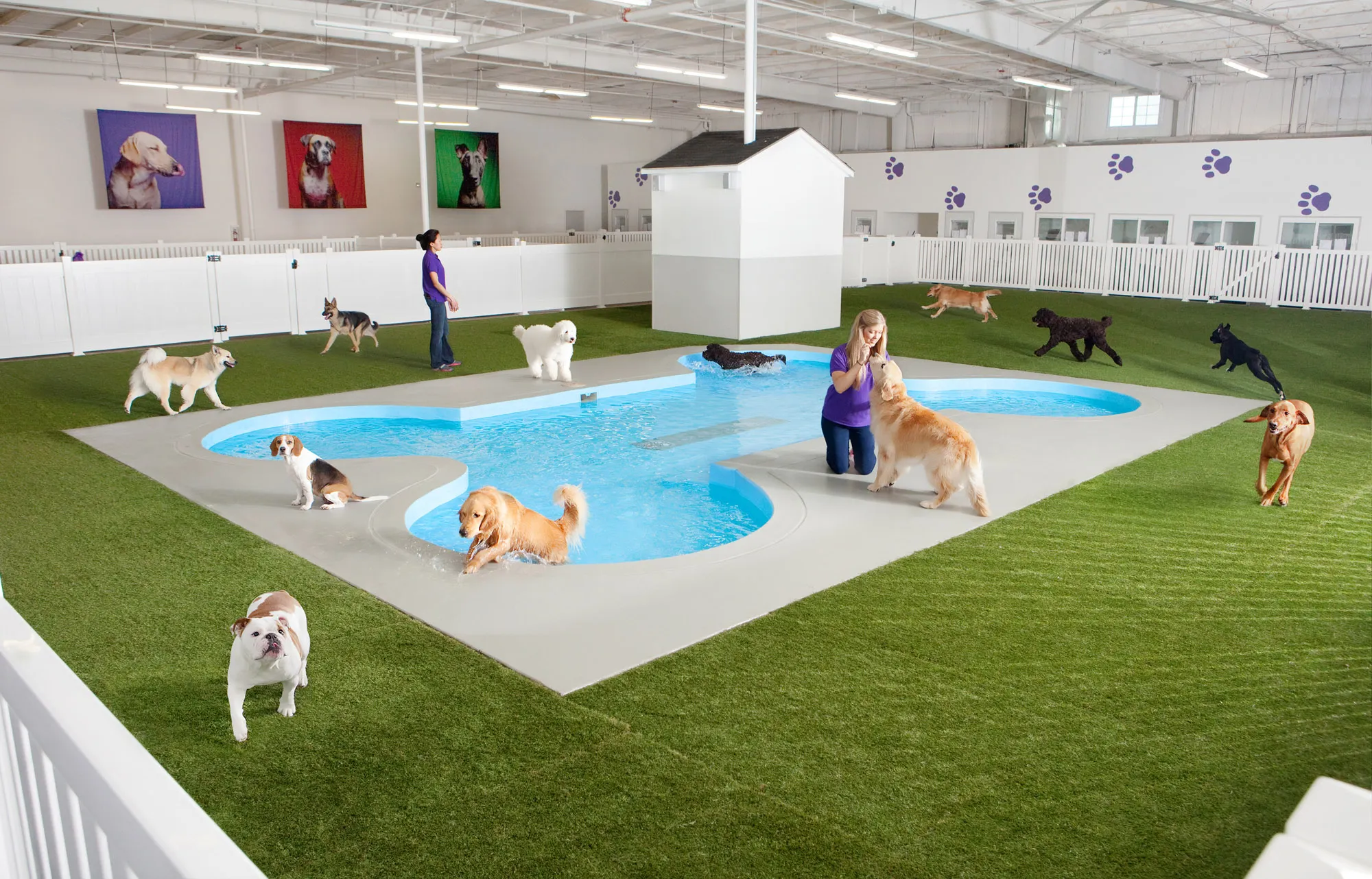
Working Breeds
German Shepherd Intelligence: Uncovered Mind, Memory, and Mental Mastery
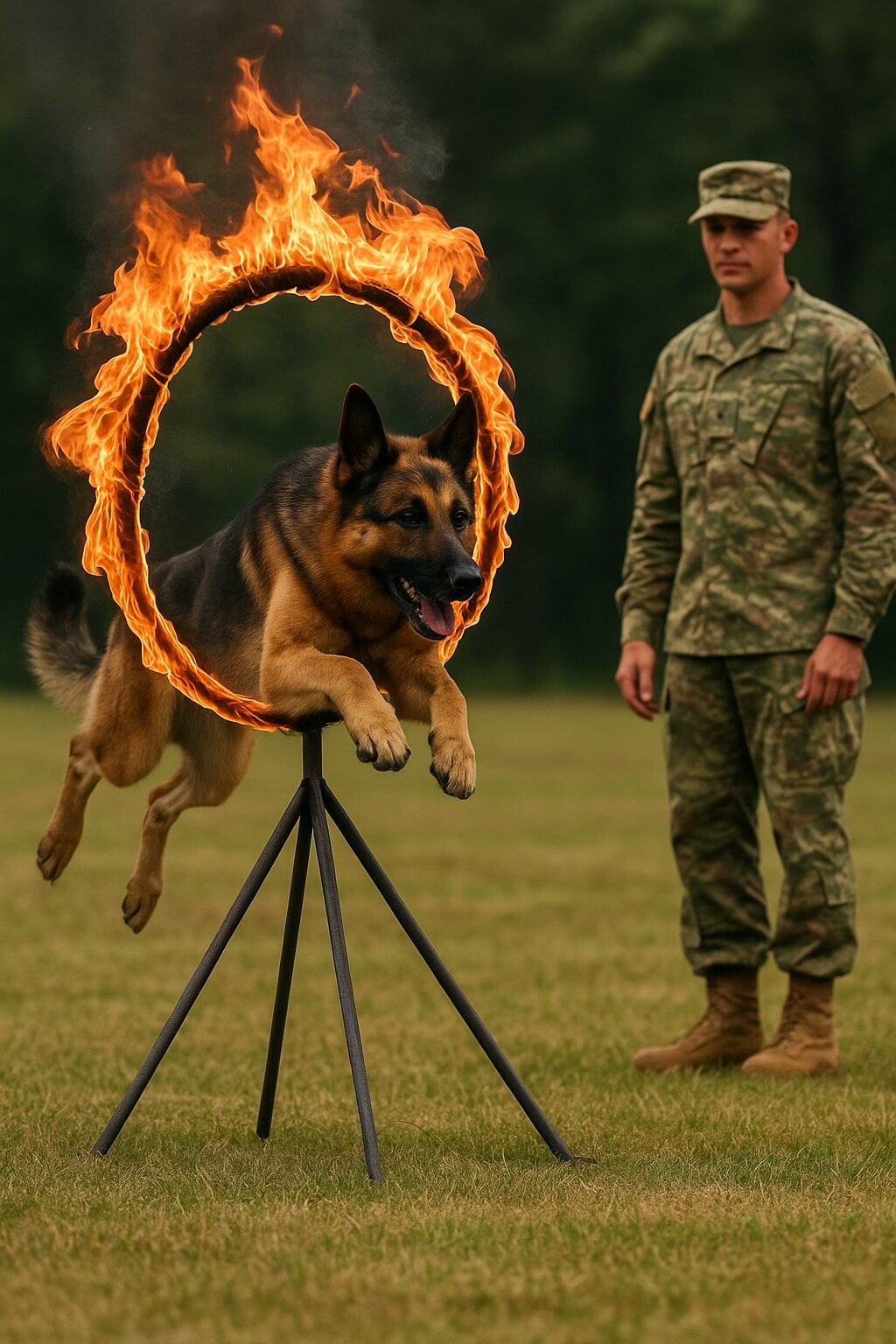
📍 Part 14 of the German Shepherd Series on DogsReader
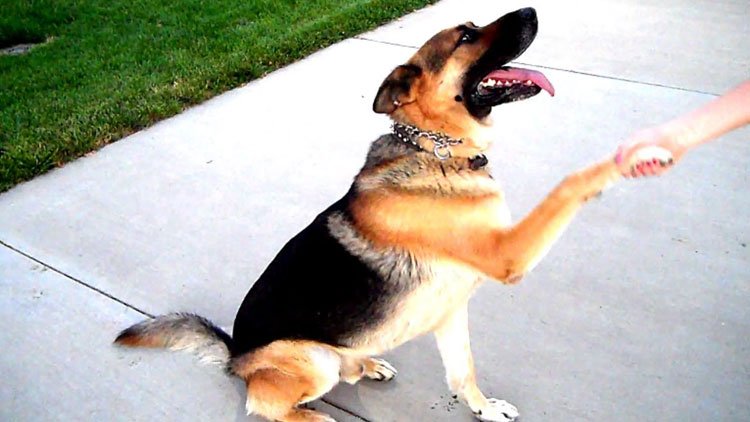
Introduction: Why German Shepherds Are Considered Canine Geniuses
German Shepherd Intelligence : German Shepherds aren’t just working dogs — they’re intellectual powerhouses. From police forces to therapy roles, their brainpower is what sets them apart. In this 15th installment of the DogsReader German Shepherd Series, we uncover the layers of intelligence that make the breed one of the most trainable and dependable dogs in the world.
Mental Capacity: Ranking the German Shepherd’s Intelligence

According to renowned canine psychologist Stanley Coren, German Shepherds rank 3rd among the most intelligent dog breeds, right after the Border Collie and Poodle. But their intelligence is not just about performing tricks — it includes:
-
Working Intelligence: Quick command response time
-
Adaptive Intelligence: Problem-solving based on real-life experiences
-
Instinctive Intelligence: Natural ability to guard, herd, and protect
Short-Term Memory vs. Long-Term Memory in GSDs

German Shepherds are capable of retaining both short-term and long-term memories.
-
Short-Term Memory: Allows them to react and learn commands within seconds
-
Long-Term Memory: Enables them to remember people, places, and training even after months or years
➡️ This is why military and police units invest in them – their memory retention is unmatched.
Mind Mapping & Cognitive Training

GSDs have the ability to mentally “map” their environment. With consistent training, they learn:
-
Names of toys and family members
-
Task sequences in protection or obedience routines
🧠 Mental stimulation is just as important as physical exercise. Neglecting either can lead to behavioral issues.
Examples of Mental Mastery in Real Life
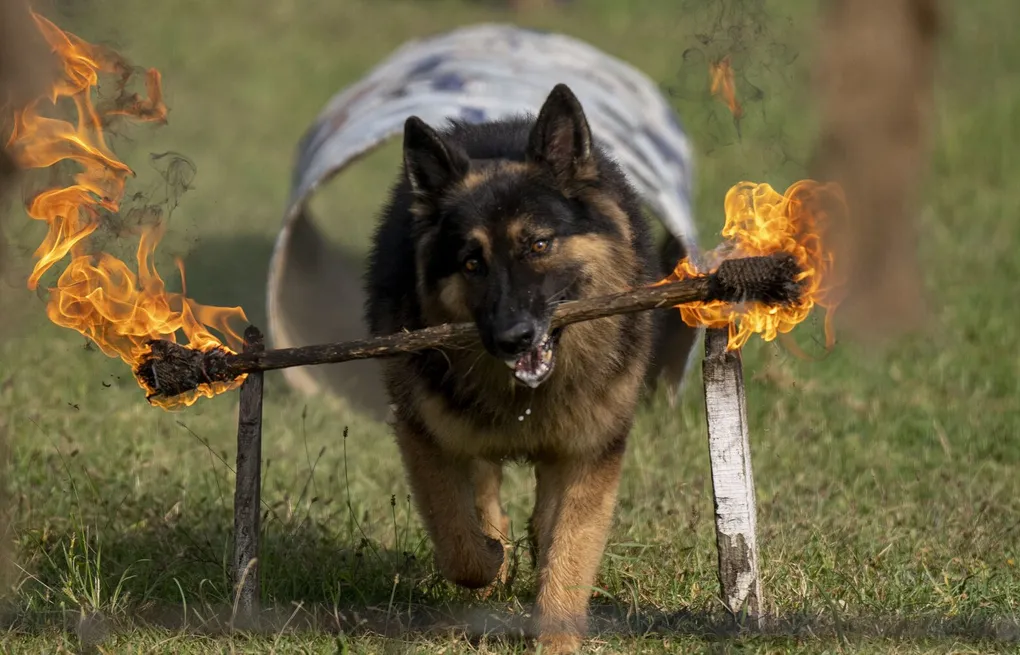
Here are true-to-life demonstrations of the breed’s cognitive excellence:
-
A retired K9 officer named Max once tracked a missing child 2 miles away using only a blanket as a scent source.
-
Luna, a therapy German Shepherd, learned to recognize anxiety attacks in her owner before visible symptoms occurred.
-
In competitive obedience, German Shepherds consistently outperform other breeds in multi-step routines.
Best Brain Games to Unlock Full Potential

-
Find the Treat: Enhances scent memory and reward-driven focus
-
Puzzle Toys: Keeps their problem-solving skills sharp
-
Name That Toy: Teach them toy names for vocabulary expansion
-
Hide and Seek: Stimulates hunting instincts and recall memory
-
Command Chains: Train your dog to follow multi-step commands
💡 DogsReader Tip: Change up the difficulty level every week to avoid cognitive stagnation.
How to Identify Cognitive Decline Early
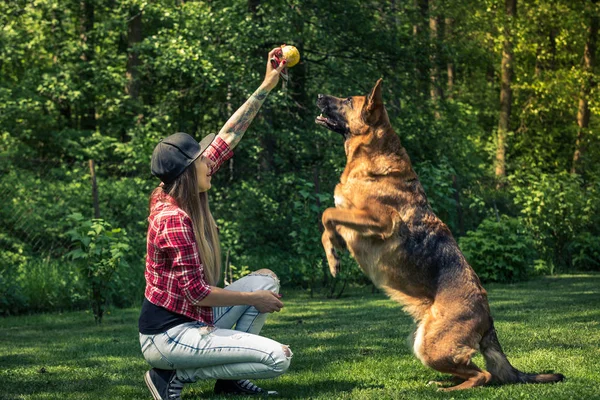
Even the smartest dogs age. Watch for signs such as:
-
Hesitation in routine tasks
-
Forgetting commands
-
Disorientation in familiar environments
-
Increased anxiety or restlessness
📌 Early diagnosis leads to better mental wellness treatment — explore our upcoming article on “Senior Care for German Shepherds.”
Closing Statement : The Mental Marvel That Is the German Shepherd
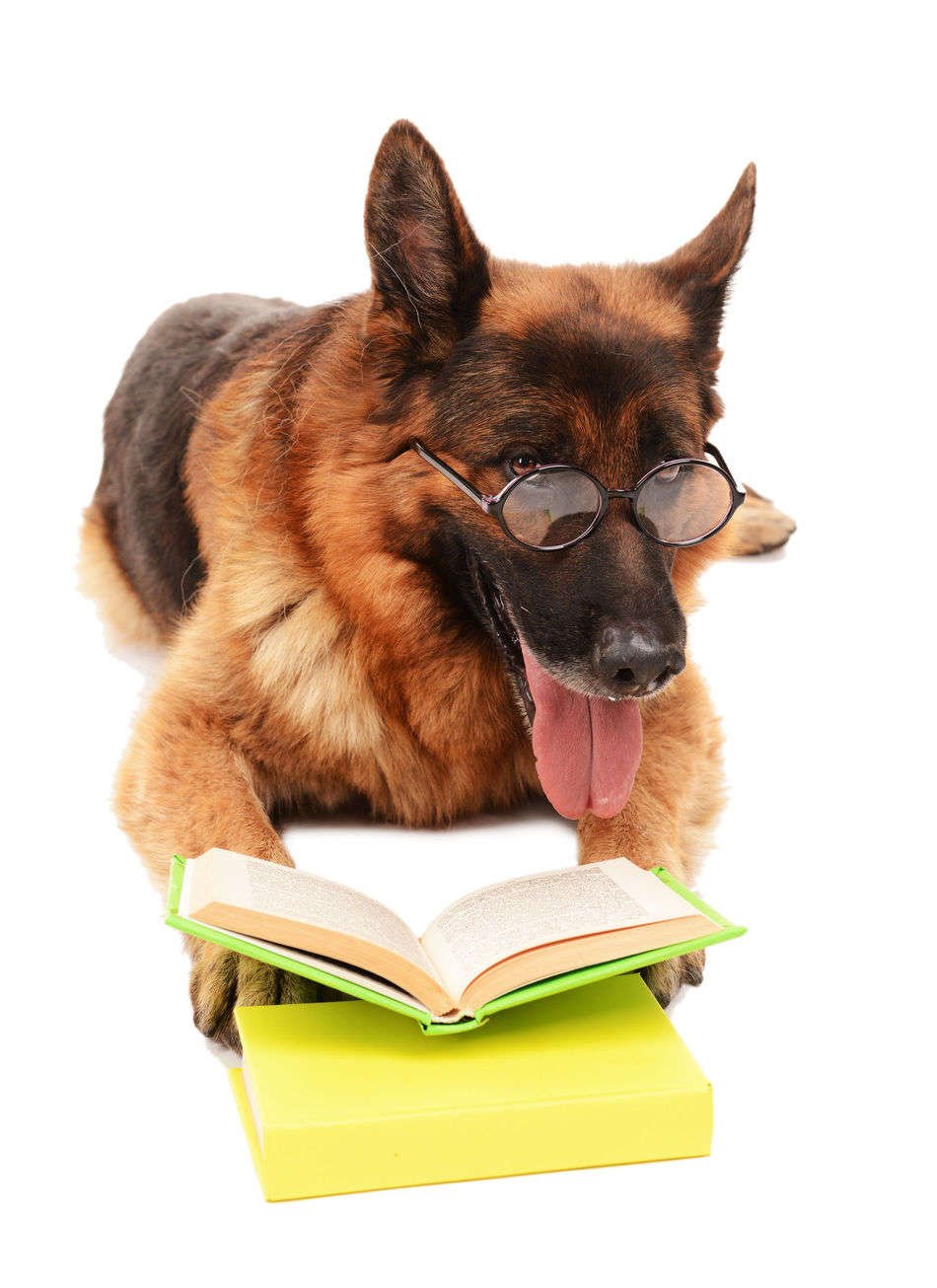
Their intelligence is not just in obedience — it’s in their emotional depth, decision-making ability, and working dedication. From pup to elite performer, a German Shepherd’s brain deserves to be nurtured just as much as their body.
📢 This is Part 14 of the German Shepherd Series on DogsReader
Discover all parts of the series and exclusive dog care knowledge on our website.
🐶 Visit: www.dogsreader.com
📩 Ask our 24/7 Dog Chatbot anything – trained with official AKC knowledge!
📧 Contact: dogsreaders@gmail.com
📱 Follow us on Facebook & Instagram [Subscribe to us on YouTube | Facebook | Instagram | www.dogsreader.com]
▶️ Subscribe to us on YouTube!
FAQs
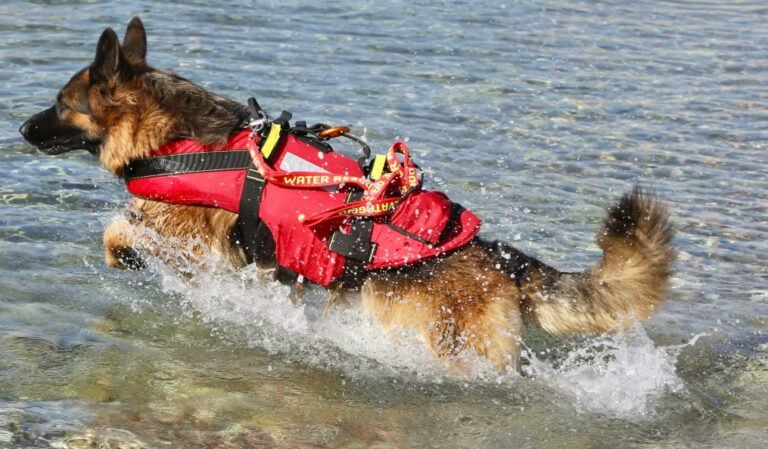
“German Shepherd Intelligence Uncovered: Mind, Memory, and Mental Mastery”
1. Are German Shepherds really smarter than other dog breeds?
Yes, German Shepherds are ranked as the third most intelligent dog breed in the world. Their quick learning, emotional intelligence, and memory retention make them top performers in obedience, protection, and service roles.
2. How intelligent is a German Shepherd compared to a human?
A well-trained adult German Shepherd has cognitive skills comparable to a 2.5 to 3-year-old human child. They understand hundreds of words, can follow multi-step commands, and even interpret emotions.
3. Can German Shepherds remember their owners after years?
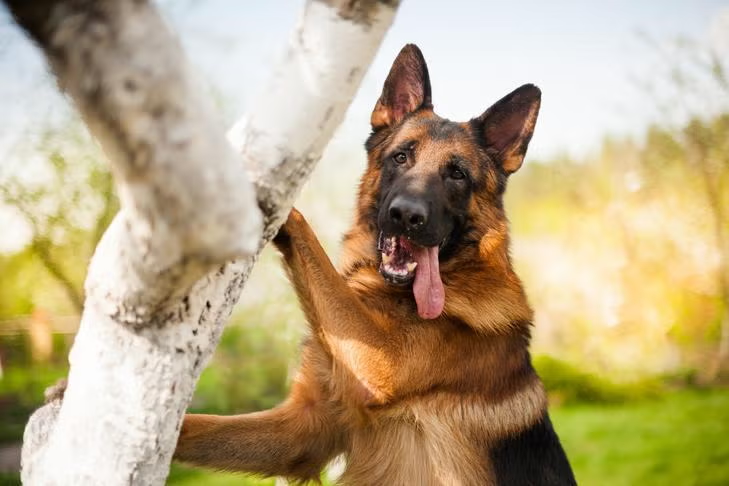
Absolutely. Thanks to their strong long-term memory, German Shepherds can remember their owners, voices, and environments even after being separated for several years.
4. What kind of mental games do German Shepherds like?
German Shepherds enjoy puzzle toys, scent games, name-learning challenges, and hide-and-seek. These games stimulate their brain, reduce anxiety, and prevent boredom-related behaviors.
5. Do German Shepherds have better memory than other breeds?
Yes. Their working memory and adaptive intelligence are superior to many other breeds, which is why they excel in military, police, and therapy roles.
6. How can I test my German Shepherd’s intelligence at home?
Simple games like “which hand has the treat,” toy name recognition, or obstacle challenges can help test your German Shepherd’s problem-solving ability and memory recall at home.
7. How much mental stimulation does a German Shepherd need daily?

A German Shepherd needs at least 30–45 minutes of mental enrichment daily in addition to physical exercise. Without it, they can become restless, destructive, or depressed.
8. Can German Shepherds suffer from memory loss or dementia?
Yes, senior German Shepherds can develop Canine Cognitive Dysfunction (CCD), similar to dementia in humans. Early signs include confusion, changes in sleep, and forgetting commands.
9. What is the best age to start brain training for a German Shepherd puppy?
You can begin simple mental games and memory exercises as early as 8 weeks old. Start with basic commands and short tasks, then gradually increase difficulty.
10. How do police German Shepherds train their memory so well?
They undergo repetition-based and scenario-driven training that conditions them to remember commands, scents, routines, and locations even under stress or distraction.

-

 SMALL DOG BREEDS5 months ago
SMALL DOG BREEDS5 months agoMerle Chihuahua: A Comprehensive Guide
-
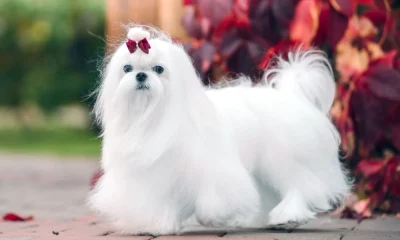
 SMALL DOG BREEDS5 months ago
SMALL DOG BREEDS5 months agoMaltese: A Beloved Companion
-

 Large Breeds4 months ago
Large Breeds4 months agoSamoyeds Hypoallergenic: Closer Look at the Breed
-

 SMALL DOG BREEDS5 months ago
SMALL DOG BREEDS5 months agoMerle Pomeranian: A Adorable Companion
-

 Large Breeds4 months ago
Large Breeds4 months agoStandard Poodle Weight: Country Wise
-

 MEDIUM BREEDS4 months ago
MEDIUM BREEDS4 months agoAmerican Water Spaniel Colors Chocolate In Crcols:
-

 SMALL DOG BREEDS5 months ago
SMALL DOG BREEDS5 months agoYorkshire Terrier: a Big Personality
-

 Terrier Breeds3 months ago
Terrier Breeds3 months agoDog Breeds: by Country & Category







